ENOUGH [BASTA][Field Scan, Illustrations & Notes][Draft/BETA]
 Monday, June 25, 2012 at 10:52AM
Monday, June 25, 2012 at 10:52AM 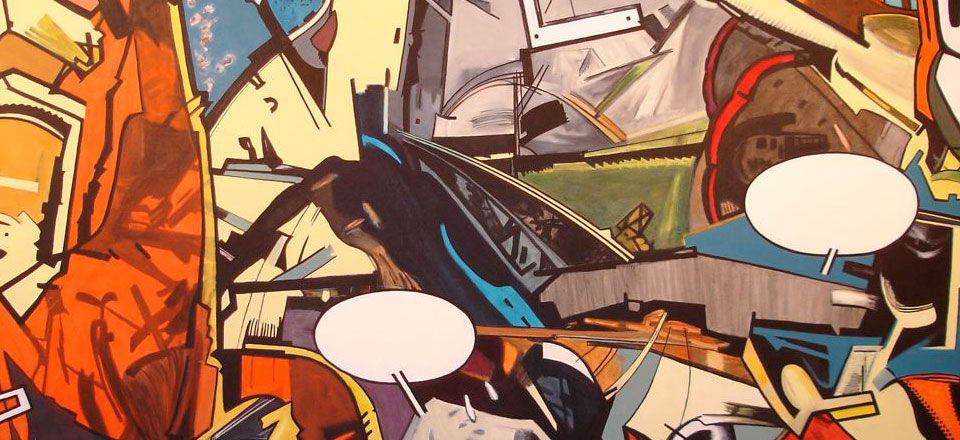 Painting by Manning Williams (d. 2012); Click the image to see BBC Nightfilms segment/read text by Paul Mason "Does Occupy signal the death of contemporary art?" featuring Mark Read, Molly Crabapple, and other Occupy artists commenting on the evolving role of Occupy art in shaping the domain.
Painting by Manning Williams (d. 2012); Click the image to see BBC Nightfilms segment/read text by Paul Mason "Does Occupy signal the death of contemporary art?" featuring Mark Read, Molly Crabapple, and other Occupy artists commenting on the evolving role of Occupy art in shaping the domain.
ENOUGH [BASTA][Field Scan, Illustrations & Notes][Draft/BETA]
By Paul McLean, edited by Chris Moylan
 Homemade guillotine (see links below).<[PLATFORM]: TIME IS THE ONLY OBJECT. EVERYTHING ELSE IS THE (A) SUBJECT.
Homemade guillotine (see links below).<[PLATFORM]: TIME IS THE ONLY OBJECT. EVERYTHING ELSE IS THE (A) SUBJECT.
 Ale at the G20 conference
Ale at the G20 conference
>>
Way to go, Ale! I can't read everything but I do like the idea that the appearance of an analog object in digital time is what people need to awaken their poetic sensibilities.
<<
- Jez Bold [response to Ale's revGames/DA Flaneurs performance at the G20]

Installation View, 1995
Chema Alvagonzalez, SITE Santa Fe
Available
>>
SITE Santa Fe lies on the edge of town by the railroad tracks, at a welcome distance from the schlock art malls of Canyon Road and the tourist-friendly museums in the town center. It’s a relief to enter a white box environment and discover some challenging art. As the title of the current exhibition suggests, Time-Lapse showcases pieces that either address the subjective experience of time or rely expressly on the passage of time to achieve full realization. Works accrue gradually, offering visitors a unique viewing experience every day, if not every minute. Despite the variety of media employed and the evolving nature of the work, many of these individual pieces gather in force to represent some of the paradoxical concerns of our collective human existence.
...
Time-Lapse achieves its goal of deconstructing the notion of artwork as static and immutable. Along the way, it highlights how some thoughtful artists search for an understanding of global forces while others elect to deal with the mundane physical and emotional needs that shape daily life. Still other artists investigate the elastic and subjective nature of time, asking the viewer to participate in the exploration. The work on view here is revealing, both in its methods and in its conclusions about humanity, individual, and universal.
<<
- "Time-Lapse" by Corina Larkin [review of SITE Santa Fe for Brooklyn Rail]
 "Red Canvas" by Richard Tuttle
"Red Canvas" by Richard Tuttle
[INSTRUCTIONS]: Over the next few days I'll be correcting/modifying the following field scan, editing for content, grammatical errors, typos, all the usual remedial crafting against imperfections crap; and revisioning, continuing the linking process, adding data, etc. [For instance, today I discovered that a link to the Department of National Intelligence report "Mapping the Global Future," sometime in the last 12 hours or so, since the time when this blog was first published, had been removed! A placeholder image replaced the dead link (see below), and I found the entire text of the report containing the linked image, and the entire text of the report was embedded in the original gif's stead... For those who'd like to know more about how your future is being determined for you, without your knowledge or consent, from the top-down, and across the globe, by multi-national corporations, NGOs and who knows who else!] Initially, a small team of collaborators will be helping with this iteration of E[B], reviewing, critiquing, reforming it, etc. These include Chris Moylan, Jez Bold, Alex Carvalho and a few others. The meta--text we're going to think of as a wireframe, an armature, a skeleton, a trunk (as in, of a tree)... that resolves, revolves, spirals, disperses, blurs, re-emerges, manifests as actuality, with time. [Stopping here for tonight - PJM/6-27-2012][Due to some bizarre software glitch, or who knows what, the modification to the text I made this morning disappeared. I am trying to repair and repost it from memory, and it's not going well. An additional text by Alex and video by Jez were added below, after a phone conversation at 9AM - PJM/6-28]

{Attachment: Author's Note > This is the paragraph that underwent substantial modification this morning, and then the modifications somehow were erased (about the same time the Department of National Intelligence link disappeared, although the timing was probably coincidental). Anyone who has worked in the digital medium for any length of time will empathize with the horrible experience of loss attaching to such events: the feeling that an investment of one's "human capital" into a computer-based architecture evaporates and is unrecoverable. I thought the autosaving function was protecting the work, but that evidently was not true. Anyway, I will do my best to re-construct the revision here.}: The Larkin quote above needed to be inserted in proximity to the TIME-OBJECT reiteration, I thought, mainly to illustrate the currency of time in the top-tier art world. If the art world has a mainstream, it would course through the -ennial circuit (or "circuitry," to adopt a mechanical, electronic network metaphor) to which SITE Santa Fe belongs. And to call attention to how Time is situated therein incorrectly, routinely, not just through contextual materials or thematic narratives established by presenters, but through the lens of the critic. Quizzing for SITE Santa Feans and/or Ms. Larkin: Does time lapse, or is stop-start time or time-break/pause-time only an illusion, at best a conjecture, or should we just mull over time in all its forms of technical glitch, a secondary or tertiary or... phenomenon existing contemporarily in the spheres of translation, interpretation, digitization, compression and on and on? Our first order premise, Time is not subjective, but we as subjects to Time are, should ought to be addressed. Time: Object; me/you/+ : Subject; Isn't that a point worth distinguishing? Another thing. How is time "elastic?" [Not a critique of the critique - 06/28]
... About the beginning. "Way to go, Ale" is the apparent start of this text, after the titles, and platform, but that's new, an insertion, which happened after the Larkin quote insertion. So, let's pretend it isn't there, now, and that the Larkin quote is our point of origination, our first reference. [I've found I cannot rewrite this section of the lost text, which discussed the Opening Line in literature, the drama of the writer struggling to initiate her story with a great opening sentence. Like "In the beginning, there was the Word..." or "It was the best of times..." etc. The cinematic cliche of the author at the typewriter, chainsmoking, a dingy hovel of a flat, best shot in black and white film, hyper-focused, the pervasion of the scene with overbearing music or a clock ticking, a metronome, maddening amplification of small noises, the window through which we see the cold city reduced to flat or dull tones of stone and steel, dirtied by smoke, the bright winter sky blurring the edge of his silhouette as he paces between the window and camera, stalking the paper in the typewriter, or something like that... While the writer paces, sits, looks out the window, smokes, drinks, waiting for that great first line, there is a throaty voiceover, narrating the story that won't be written, not to be delivered by the Muse, or some literary angel... anyway, I'll stop here. The lost one was so much better.] Anyway, our text starts not with an original thought, but with the quotation of another's, who is writing about an art show. It's derivative.
I have to point out the SITE review's opening sentence applies more to the discussion of Manning Williams, a so-called regional artist, than the other narrative, about time, but only culturally or socially. Larkin's jaundiced opening salvo reinforces the stereotype of the NYC v. provincial art market perceived, parsed or pierced through the lens of the urban-centric critic. Tony Horwitz talks about it in the same article cited below, how critics from Northern newspapers bitched about the South. But whatever animus civilized arts writers spew in their columns, it's nothing compared to the heinous vitriol spouted in comments fields across the web. YouTube may have the most vicious commenter culture outside of 4Chan, but the Washington Post's is hardly a nice neighborhood. Ask their OMG-Robby-the-Robot-this-is-good-for-free-speech Ombudsman, who enables the paid contractor trolls and justifies their making the free speech sections of the site uninhabitable for a nice person. Also Larkin's short-take is not only insufficient, it is superficial and flawed. One reason for Santa Fe's continued success as one of the nation's premier (international) art destinations is its rich arts/culture/market ecology, which is unique. The "white cube" complaint Larkin enunciates is - how do you put this? - a running gag in the land of adobe abodes, except where the cube amounts to an ongoing dimensional project taken on by Santa Fe's many cubist refugees or reformers, who include luminaries like Tuttle, who rotate between the two domains (cubic and whatever the enchantment architecture of northern New Mexico actually is) to great effect. [: Richard says, "My art partakes of the space between the polarities of architecture and calligraphy." This statement refers to our approach here fundamentally.] ...And the descriptions of individual artist projects in the article apply more to the discussion of globalism-corrupted art at the institutional top-tier than either the documentary text in Larkin's essay or the issue of critical bias against all but the open-air big-box art market factory outlet mall that is Chelsea and the 1000 other 1% art labs in NYC, and 1000 less-than other ones elsewhere across the land. Both threads could be expanded on, but won't be here. I will add a brief anecdote, though. In the first half of the 90s, I hosted a local radio show in Santa Fe called "Art Talk." On one of my programs several VIP guests (Ron Robles, Elias Rivera and Bruce Ferguson) visited the tiny local station and studio to discuss, among many other artsy things, the soon-to-open SSF. I got schooled as usual, but the venerable panel were kind and encouraging. Bruce curated the first biennial and was then the executive director. I'm going to try to find the cassette recording of the show (to my knowledge, I possess the only copy), because I can barely remember the amazing conversation that these three had mostly and thankfully with each other. I do recall Elias advising me at some length on surviving as an artist. The metaphor he used was the long-distance race. "Eventually, the pack thins," he said, if memory serves. It is worth comparing the platform text for Ferguson's SITE opener, Longing and Belonging (July 14 – October 8, 1995) with the description of Time Lapse by Larkin:
>>
Longing and Belonging was the inaugural exhibition at SITE Santa Fe. It included 31 international artists who all explore identities in global culture. This exhibition mirrored SITE’s mission of bringing the “faraway nearby” by bringing objects and images from the international community to Santa Fe. It also addressed culturally-based ideas of permanency, displacement, exile, and heritage, among others.
<<
Artists who participated in L&B include Marina Abramovic, Francis Alÿs, Felix Gonzáles-Torres, Jenny Holzer, Anish Kapoor, Bruce Nauman, and Andres Serrano, plus many others you might recognize, dear artsy reader. SITE was ahead of its time, then. What is it now? That was a trick question. Time Lapse closed May 20. I won't get to see it. I guess there's always Marfa, for those who prefer the gesture of permanence to the global art march of the periodic installation as spectacle, and the clock. The two modalities resemble one another, but they are not identical. For the purposes of rhetorics, which is truer? From my perspective, post-OWS (9-17), all such narratives - and exhibits like Time Lapse, are now irrelevant in many of their most important aspects, and most importantly in their contemporaneity, even though the armies of industrial, speculative and commercial artists and culture workers who stage them or assign meaning to them appear not to realize this "new" actuality, or if they do, don't know what else to do about it. One can really get the sense of this in NYC this year, as the calendar rolls on, over art fairs, museum blockbusters, gallery shows, projects, panels, and the rest. On the Western Art Front, there is unease, as if time is running out, and it is. In some areas we have the usual anomalies, that act like the refresh button on a browser, for an ever-static money churning art machine, the scenes that are burgeoning as underground medicine (Christian Moeller's term, not the new media Christian Moeller, the Berliner painter one). Bushwick is one of those. It has to do with stuff that terms like collectives, DIY, pop-ups only begin to describe, but which in their precarity, resist all scripts, instead prefering encryption, as a hedge, as a dimensional technic for survival. Just stand at the corner of Troutman and Scott, and spin. You'll see what I mean. The phenomenon has more to do with Occupy than it has with the Armory Show. For this art vet, it really is neat to be in the middle of this happening, and what I'm referring to has fuck-all to do with gentrification, really. It is perceptual, as Drucker said of Japan, LOL. I haven't noticed anyone getting this yet in the glossies, but then I haven't picked up the new Art in America, yet, either. Resistance! Just to drive it home, does anyone remember Bjork's husband's show at Shaulager in Basel in 2010? Resistance, restraint, what's the diff? By the by, Bjork is doing museum work too now, and maybe it's sustainable, as such. She's become a culture worker. It's a Creators Project thing. It's creative. Innovative.
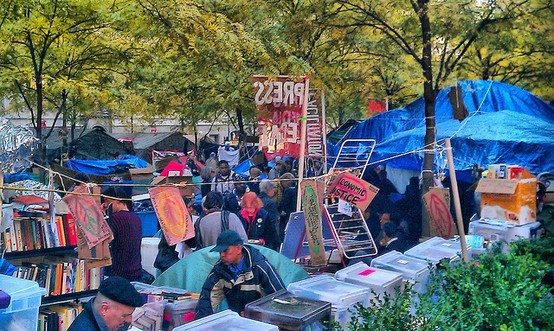 From Daniel Latorre's Occupy Environmental Design's Pinterest pinboard
From Daniel Latorre's Occupy Environmental Design's Pinterest pinboard
[INTRODUCTORY NOTES]: Sometimes when I undertake a dimensional analysis or field scan, the subject expands at a rate that outpaces the initial concept framework, including authorial areas of interest. (Now, including areas of Pinterest). The essay* below commenced just prior the nine-month anniversary of OWS. Nine months, the time it takes to hatch a lttle human. Before the fact, undertaking this particular ENOUGH entry seemed a rather dull and anonymous exercise, a technical, perfunctory slog. I view evaluation as a necessity, but I have often considered documentation of the eval less a necessity, than a chore, and sometimes other chores take precedence. Also, I was under the impression, wrong as it turned out, that the whole world isn't watching Occupy, to paraphrase the street chant. Okay, that's hyperbole. A lot more people are still keeping an eye on Occupy than I thought. Morale is a factor in motivation. It's been tough to get motivated lately for Occupy-related work, for a lot of reasons, most of them reasonable, none of which I'll list here. OWS and OWS Arts & Culture is molting, and shedding skin is a painful process. Finishing the thought with another metaphor, a smarmy one, the clouds are parting.
*[MILO (sincerely & critically, on the form of the document)] Q.: What kind of "essay" consists of basically 1-1 ratio of image to text? A.: A story in a children's book; OK, not exactly an essay, as such. A2.: A field manual. PJM: OK, this may not be an essay exactly , as such; it is web-native, and not a simulation of an essay. The blog is not necessarily the optimum container for all that we're trying to do here. For one thing - tracking corrections isn't possible with the basic tools in our back-end toolbox. Chronology of edits isn't transparent, therefore. We're making due, for now, and looking for solutions... please bear with]
Let's summarize our (initial) self-assigned struggle/mission/task for the the "essay":
- responding to some essays published recently that have to do with the state of the art of Occupy
- making some general assessments about media practice affecting mass perception
- focusing on the erasure of national and regional history
- calling out the top-down art/academic/philosophy/media/press complex's sublimation or outright repression of Occupy art
- analyzing how Occupy art or OWS generally is being folded it into the "new"
- chronicling how artists manage to do the same thing from the bottom-up
- "coloring" the data with autobiography and anecdotes, the subjective
I guess it's obvious why the essay evolved into an exercise not unlike the barking dog chasing the big truck down the street. What does he do, if he catches it?
Well, the "essay" is about 15,000 words long now, contains over 200 "illustrations," has become an open-source editorial experiment and has already been significantly restructured in its internal architectures several times. Every time one hits the button "Save & Close" the dog seems to "catch the truck." Every time the editing window is re-opened, the truck gets away. What to do, what to do?
One way to reboot the effort, to restore or create a rational flow to the text is to go back into it at multiple points to striate narratives. The goal being to clarify the distinctions among the multiple interwoven narrative threads. Another is to post-facto create a logic that serves to illuminate the internal order in the data, which is fine when the order of data actually exists. Another is to refuse epistemology altogether, in favor of myth, or poesia, infusing the text with eros, artes... Another is to push the work as a unit toward something like illuminated or enlightened vision, as reason. My take on a Hegelian turn: Spiritual doctrine provisioning a storyboard methodology would have been helpful, as a structural device, but since this particular meta-narrative is forged or animated by the broadest or simplest notion of "spirit," and eschews ideology, theology or any dogma as such, we are left to the aesthetics of streaming media, with bandwidth that drops frames from time to time, causing considerable user hardship, frustrating the smooth reception that only the big outfits tend to manage well, with their high production values and big bucks. However, since the author posits ENOUGH! more or less as a stub, in the WIKI sense, and the text an additive N+1 (dimensional) one, the problem is not a problem, but an invitation to other authors to contribute. Also, dear reader, please keep in mind, that the composition is not an epistle project, but an exhibition component. At the point of output [likely a big beautiful barn in Huntington, LI] we will have a variety of options besides printed matter for presenting the work. The text could be, for instance, re-formatted by collage technique, multi-channel/layered projection, or cut & composited on transparent acrylic, or might appear only as a sonic iteration, etc...
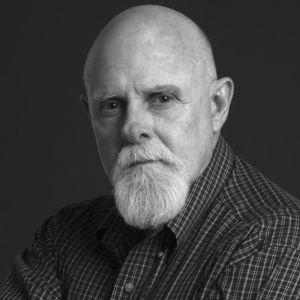 Manning Williams
Manning Williams
This segment is dedicated to Charleston, South Carolina-based painter Manning Williams, who passed away June 15. My Bushwick metal worker friend Cliff Hawkins asked me to Google Manning. Cliff was on his way home to serve as pallbearer at Williams' funeral. After visiting a few of the artist's links, and thinking about some of the stories Cliff shared with me, I felt like Manning perfectly represents a stratum in the American art world that co-exists with the "art world" so routinely conflated with art in this country. The former's roots are deeply embedded in regional centers across the land. Artists like Manning demonstrate a very different kind of relationship that develops over time between an artist and community outside of New York and the few other art markets that monopolize the discourse about who's an artist, what is art and what art's for. Williams was not a global artist in any way I can identify, although his comic book-inspired abstractions certainly are art historically relevant, especially for American art history. I'm not surprised I hadn't crossed Williams' path in my navigation of the American scene over a 30-year span. There are a fair number of painters like him, although it seems fewer and fewer - but this may be but seeming. Having worked in the Santa Fe art world for a decade, and being familiar with Southwest and Cowboy Art traditions, for me the Manning Williams profile is familiar. The southeast and other regions have produced variations on the phenomenon. One example is Morris Graves in the Northwest, who also developed ties and a following in New York, nationally and internationally, although his career trajectory is fairly rare. Another one is TC Cannon, who to my mind is one of America's unique and important painters, although I never hear him mentioned.
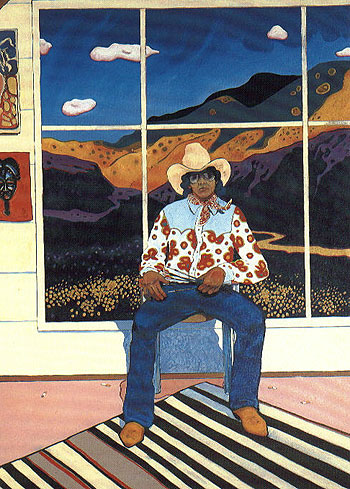 Self-portrait by TC Cannon
Self-portrait by TC Cannon
Throughout the text I'll sprinkle bits of Manning Williams' story like ashes. I think Williams is a good juxtaposition or comparative for a lot of what's described below, especially with respect to the work of Taeyoon Choi, and the processes practiced at the Berlin Biennale 7 by the Occupy people.
 Taeyoon Choi at Liberty Square, post-N-15
Taeyoon Choi at Liberty Square, post-N-15
In the first case, I think the differences are clear enough to require little elaboration, assuming the reader will drill down into the bios & materials. The same holds for the collective actions of the neo-protestant wing of Occupy art - actions which are not readily recognizable as artistic action, as such, in the plastic tradition, let's say. The Occupy crew in Berlin, if one didn't have a caption and backstory, could be planning a bake sale, if you only had the pictures to go on. A really weird bake sale, maybe.
 Occupy at Berlin Biennial 7 - the "human zoo"
Occupy at Berlin Biennial 7 - the "human zoo"
I don't want to make too light of the point, though. It goes to the heart of the cultural war for power over the perceptual field, who has agency in it, and the mechanisms that constitute an "apparatus," as Choi describes it, sort of. Culture is a medium of media, more than art is, at least for a painter like Williams. For Williams, attention from media was a by-product of performance over time and localized accomplishment, of embeddedness. Compare Williams' trajectory with Occupy's meteoric one (media-wise), and outside of Occupy with Art, little has happened to begin the permaculturing of Occupy at the grassroots level. As media content, Occupy art is undergoing reformation persistently in the establishment and academic art domains. Problematically, this entails the re-purposing of Occupy into the domains of culture work or media philosophy, or worse, the 1% art market and press (see Art in America, June issue).

The processing of Occupy into course material and cultural currency in the international art event circuits is happening on a normative basis. The tension among art worlds like Manning Williams' and the ones into which OWS art is being re-situated is almost a cliche. Mockery is a two-way throughput between the art worlds' non-referential combatants, and this is clear over the past seventy years or century, but most clearly over the past thirty, over which period the term "culture war" came to describe the dimensional struggle for primacy at the levels of national politics, international art markets, the art departments of universities and colleges across the land and globe, and in the studios of artists from everywhere who still aspire to make it in New York (or even in their own neighborhoods or towns, cities, etc.). The term "culture war" is fungible and is now blurred into many debates, like abortion or immigration/gay/gender rights, most of which don't have anything at all directly to do with art and its definitions, something that advocates (and their foes) in those issue-centric silos do not as a rule accept. That said, the issues of - federal art funding, press coverage of art, arts education and the place of art (in a losing competition with consumer portable versions, for example) in society for the "masses" - are critical to 99% art, and in the inverse, for 1% art, too, but in altogether different ways. To offer an illustration, on the effects for the command-control complex, due to the fracturing of 99% and art, posed as questions, attached to major "art" or "culture" events: Does the 2011 Venice Bienale American art pavilion represent the 99%? Did the American pavilion at the World Expo in Shanghai, a blatant corporate takeover of the cultural representation processes of this country on the international scene and an almost uniformly critically-reviled flop, do anything (positive) to enhance - or at least convey fairly - the "image" of America abroad, as the American 99% identify it or with it? The representation of culture, once you get to Venice or these other global forums, becomes a new animal, one that is mythic, a perception-chimera, and it's critical to understand the social purposes that attach most definitely are dimensional. To deny there is messaging involved is absurd.
Why does this matter? For many people, marginalized from power hierarchies outside their own circles, it doesn't. They don't give a shit any more, and that's an intended effect, that coincides with voter apathy, I would propose as a conjecture worth exploring. & maybe it wouldn't be a problem if everything were just hunky dorey. It's not. The 1% - 99% class war in these big arenas has never been more critical, and to its credit Occupy has indeed shed light on the problem. What will come of Occupy's good start? If the powerful and their hacks, witting and unwitting, have anything at all to do with it, the answer will be "nothing much." In my analysis, this is because the 1% recognize that losing command and control of art is a "slippery slope" thing. Next thing you know, the dominos will start to fall, and shit they really care about - trillions of dollars, the energy matrix, the Narrative, the war machine, the levers of leverage - THEIR IDENTITY - could fall away, too. They seem to think like Cartesians, but employ lots of dimensional agents in the field, so their operations continue to be FUBAR, displaying an inordinate supply of waste, outside their demand for everything all-at-once.
credit to chunjinnanman.net ; cut and converted by dpinkninja
Was Hegel correct in his thinking about concept-to-object art? I don't think so, but he was definitely right about the phenomenology of 4D progression, with respect to aspirational progressions, for production (in the vernacular of science, mind/spirit combinative formation). Which becomes increasingly problematic in the medium of endless war, of unresolved or insoluble binaries. Pre-computer, the vision of art in a constant growth cycle only seems to feed the brutal loop of Capitalism, which is ultimately reducible to addiction and slavery, which are variations of the same form.
 Scene from "The Voyage of the Hippo"
Scene from "The Voyage of the Hippo"
If it strikes the reader as odd to insert a war/art metaphor to describe the cultural dynamics at play today in "the art world," again the reader is invited to follow the manifestations of art/artist/artistic purpose through their links to academia, financial structures, political systems and the culture industry or sector, for clarification. The consequences are real enough. The slave linkage is similar. Being an art master is never more popular a designation for culture workers, and never less valuable proportionally.
 But I did find the entire document, which I'll embed below!
But I did find the entire document, which I'll embed below!
Mapping Global Future 2020
Over the years, I have found it remarkable that a painter like Manning Williams can pass away after many decades of popular work, develop a dedicated following, influence many through education and community, and never garner a mention on any of the top-tier international platform for art, artists or culture, when so many worthless, masturbatory simulations of art attract extensive coverage and comment. It's not like Williams was operating in Siberia, throughout his long and productive life, although for most of the 1% art thing, he may as well have been. South Carolina for some of the elite culture-sects in the City may as well be Timbuktu, minus the aura. Negotiating the topology of derision and celebration, in the critically-refined aeries of the vertical art schema, Shelby Lee Adams might generate some buzz, but mostly for all the wrong reasons, whatever the merits of the work. Good for a laugh at the Other's expense. Haha.
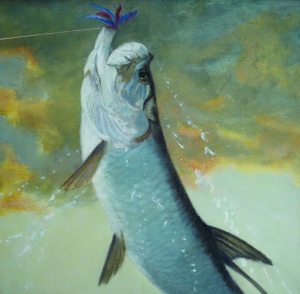 "The Proud Catch" by Manning Williams
"The Proud Catch" by Manning Williams
But then much of my time, I've worked outside of the coastal art centers and away from the mainstream art press, and the social networks that are fairly articulated and industrial at this point in the US - which in LA, New York, Santa Fe and a few other cities and destination towns like Marfa are more or less thoroughly globalized. The web has enabled and amplified this effect significantly, but that's also true for 100% of the arts and every other human subject, minus maybe five really obscure ones, which the author will favor by maintaining their anonymity, and autonomy, outside the circuitry. I guess its location, location, location, until its about URL, URL, URL, but Manning Williams didn't seem to mind not being somewhere else other than where he made his home, amongst his people, as they are and were. I have no idea what Williams might have wanted them to be, but I can ask Cliff that question when he gets back from the funeral.
 Manning Williams' studio
Manning Williams' studio
Manning Williams is dead. Long live the art of Manning Williams.
 Reuel Smith House, 1852, (Cobweb Cottage) A. J. Davis, architect; Skaneateles
Reuel Smith House, 1852, (Cobweb Cottage) A. J. Davis, architect; Skaneateles
Any serious attempt by Occupy art and culture to make inroads in this country will have to account for Manning Williams, or the movement will be a neo-colonial sham here. It will do better in Berlin, LOL. Or online. And if OWS gives a shit about 99% art here, or the 99% in general, if that Graeber+whoever meme is to have any truth in it at all, the same holds true. The problematic has already run its course in the first of OWS. Occupy Arts & Culture as an anarcho-marxian assemblea is now being shaped into an art historical widget. As is typical in contemporary art history, the apparition of A&C is being translated-documented through the lens of political/ideologicaly, prejudices and biases. Over the past several months, post-eviction, weaving through the May Day action til now, the profiling of OWS is being undertaken or platformed by "culture-worker" writers and curators like Nato Thompson, Erin Sickler, Yates McKee, Brian Holmes and others (referenced extensively in Soul of Occupy and ENOUGH! already, and in Occupy with Art texts for "Wall Street to Main Street" and "CO-OP Occuburbs"), .
So, let's get started.
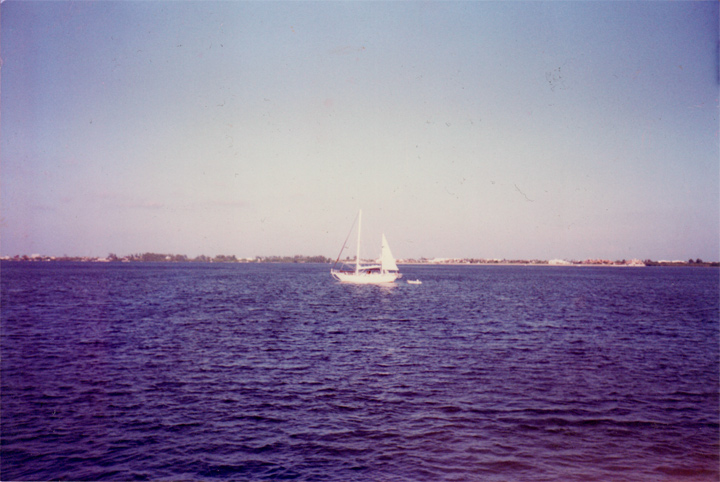 New street art in Bushwick
New street art in Bushwick
>>
Other artists, no less influenced by conceptual work, have sought to reflect critically on representations outside the art apparatus - and from there to turn back to address discourses within it. For these artists ideology cannot be reduced to one language, then critiqued, or the institution of art to one space, then charted. Such signs and sites are not simply given open to manipulation only: other meanings can be constructed, other publics sought out. Specifically, the position of the subject must be taken into account, and it is at the point of production of the subject rather than of the art object that this work intervenes.
<<
- Recodings: Art, Spectacle, Cultural Politics by Hal Foster ["Signs and Symptoms," (p. 106)]
 Exterior treatment, corner of Troutman and Scott, Bushwick
Exterior treatment, corner of Troutman and Scott, Bushwick
>>
In effect, our hypothesis is that needs (i.e., the system of needs) are *the equivalent of abstract social labor*: on them is erected the system of use value, just as abstract social labor is the basis for the system of exchange value. This hypothesis also implies that, for there to be a system at all, use valure and exchange value must be regulated by an identical abstract logic of equivalence, an identical code. The code of utility is also a code of abstract equivalence of objects and subjects (for each category in itself and for the two taken together in their relation); hence it is a combinatory code involving potential calculation (we will return to this point). Furthermore, it is in itself, as system that use value can be "fetishized," and certainly not as a practical operation. It is always the systematic abstraction is fetishized. The same goes for exchange value. And it is the *two* fetishizations, reunited - that of use value and that of exchange value - that constitute commodity festishism.
<<
- For a Critique of the Political Economy of the Sign by Jean Baudrillard ["Beyond Use Value," (p. 131)]
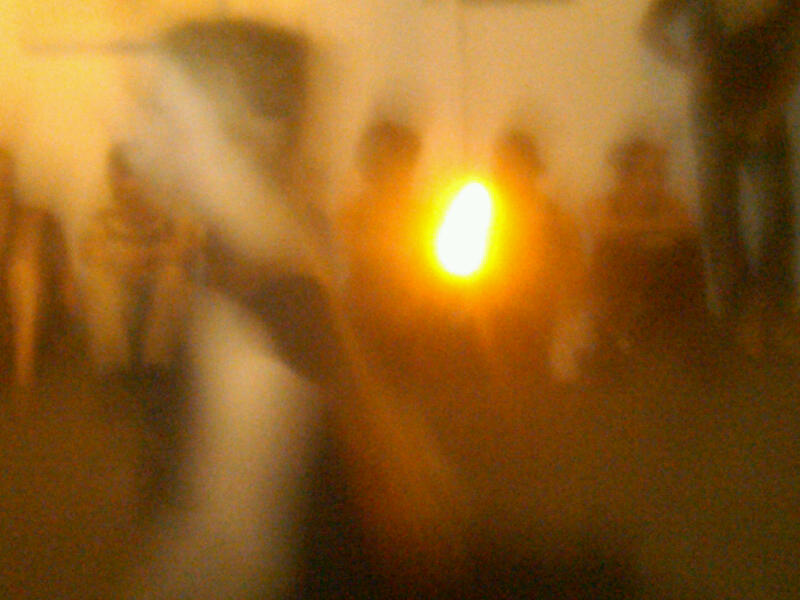 Vis-a-Vis performance
Vis-a-Vis performance
>>
as per Occupy's usual usual, the movement as such is phasing without any rational convention directing it. right now, Occupy Wall Street is not occupying anything as such, but some of the facets of it (like Occupy with Art) are still performing our stated functions. Individuals are fluidly connecting and dissolving within and around all sorts of nodes of activity, coming together more along the lines of cybernetics models, than recognizable European organizational modes. (see Stop & Frisk protest) ...Partly this is due to relentless oppressive behavior by authorities. Partly this is due to the attraction/dispersal dynamics that describe OWS from the start. Media are not representing any of it accurately, which helps no one form a sensible picture of what's happening. by the way, Occupy was never about the "other" - so when enough people stopped going to Occupy, it stopped being the phenomenon it was up to November 17 or so. Occupy is you me and anyone else who cares to say, "enough," and finds like people who are willing to stand in the face of brutal cops, lying press and politicians, greedhead 1%ers, endless war, torture and so on.
<<
- Author, from an email to Somi Roy, June 19, 2012
 Photo by Paul McLean
Photo by Paul McLean
>>
In the appreciation of a work of art or an art form, consideration of the receiver never proves fruitful. Not only is any reference to a certain public or its representatives misleading, but even the concept of an 'ideal' receiver is detrimental in the theoretical consideration of art, since all it posits is the existence and nature of man as such. Art, in the same way, posits man's physical and spiritual existence, but in none of its works is it concerned with his response. No poem is intended for the reader, no picture for the beholder, no symphony for the listener.
Is a translation meant for readers who do not understand the original? This would seem to explain adequately the divergence of their standing in the realm of art.
...
Translation is a mode. To comprehend it as mode one must go back to the original, for that contains the law governing the translation: its translatability.
<<
- Illuminations by Walter Benjamin ["The Task of the Translator," (p. 70-1)]
#Babelism & Revolutionto Marilia'Nexus: Next: Nest!' said dorothy, leaving the realm of Oz - if we can't be on the same page, how we doing this again?"
 Photo by Paul McLean
Photo by Paul McLean
[PLATFORM]: The epic is a good medium for Occupy to adopt for framing the directional evolution of the movement. Below, the author will continue the exploration of multiple narratives, woven into a loose form over the course of an unfolding or streaming data push in the Soul of Occupy and ENOUGH! sequences or series. Our themes for the latter series are:
ENOUGH! [BASTA!]
1
Derivatives
Illusion
Corruption
2
Origins
Truth
Innocence
In the Soul of Occupy sequence much of the action involved displacing from the center space of our concentricity some of the luminaries attaching to Occupy. RevGames and other parties were introduced to better represent the spirit of the movement as such, and many examples and illustrations were provided the reader to justify and/or clarify the necessity of the measure taken. We juxtaposed admonition with expression. We abutted originality with reproduction. We flipflopped the command with an imperative beyond negation. Since the entirety of our program is to cleave to dimensional realism as a truth of motion, and an impossibility as such, as task, mission and struggle, the natural thing is to fade in "educational" as an adjective applying to the activities we foreground or express. The fact that we are up to more than schooling should be obvious, but isn't. By tapping many nodes on our operational and focal sphere, permitting each its autonomy, collecting or aggregating the inputs (their outputs) without applying interference, really just linking, we can institute a conditional freedom to all subjects, while Time is Time. The space between Time and the subjects then is not mediated, itself, and the intervention on that space by other forces is revealed. It's a handy trick for finding something by the subtraction or obviation of its inverse.
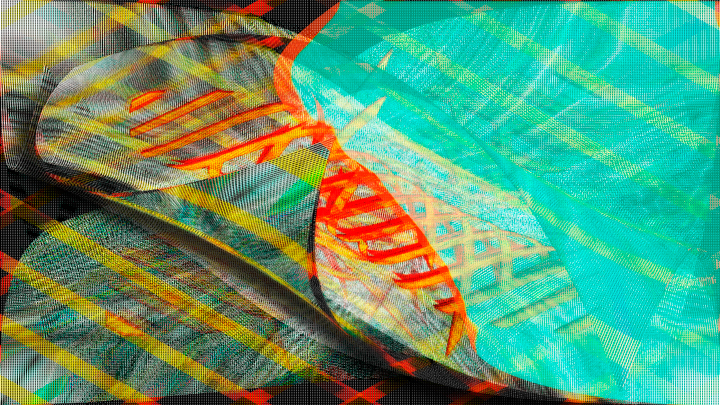 4D Phenomenon (Paul McLean)
4D Phenomenon (Paul McLean)
MILO: There's an old joke: A man approaches a boy on a beach. "I'll give you a nickel, if you can show me where God is." The boy replies, "I'll give you a dime, if you can show me where he isn't."
∞
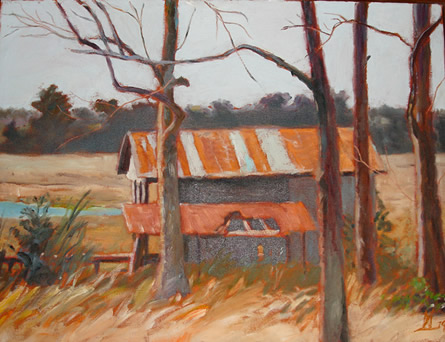 "Bohicket Creek Fish Shack" by Manning Williams
"Bohicket Creek Fish Shack" by Manning Williams
>>
As a southern of Celtic origins I grew up around storytelling. We lived on Johns Island for six years with family while my father was serving in the service during WWII. I was around country folks telling stories or making them up by enhancing or embellishing the kernel of truth to get a laugh. Painting came from that training (or competition) to be a great storyteller. Landscapes tell stories of a certain period - of that moment.
I was looking to tell America’s history, humor, “my life” in America and southern history that is such a part of my essence. I was (am) always looking for a story to tell. I continue storytelling in a contemporary abstract form now. I believe artists should be making pictures of how we are, how humans are – asking questions, presenting information, assisting others in learning to think for themselves. We need extremists’ voices to make us ask questions – unexpected comes from the wings – the extremes – it makes points that are necessary. It breaks the pattern of arrogance developed in our “knowing.”
<<
- Manning Williams (http://artwork.musc.edu/artists/pages/williamsm/01.html)
Whether you are a fan of Conrad, Cormac or Apocalypse Now, the truth is that many people around the world are pining for the end of it all, planning Armageddon, counting End Days, looking for signs the End is near at hand. One man's (or mankind's) catastrophe is another's doing the work of God. When it comes to Death of the Future of Man, unfortunately, God's work is the type of labor for a type of God for whom the periodic tantrum is bigger than Hollywood. For plenty of folks the idea of a great wind, or wave, or flame clearing the world of man starts the imaginary juices a-flowing. Some of these folks set about to start the party early. Not sure where to go with that, except to say its a kind of madness, and to suggest it has nothing at all to do with art. It's always easier to destroy than to create.
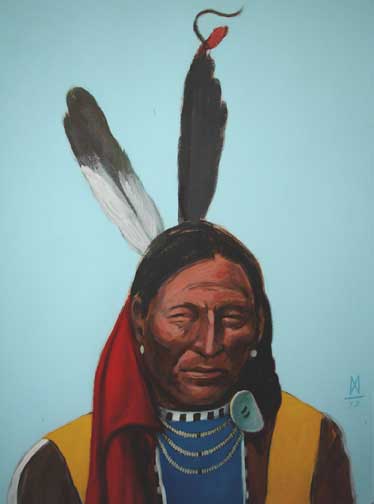 Manning WilliamsOh. & I'm not just talking about religious zealotry, fueled by doomsday scenarios, or blockbuster cinema disaster porn. I'm referencing the inconveniently truthed science of climate change, that some meta-twisted neo-sophists take as permissions to argue for all kinds of heinous praxis, including eugenics by its many names, like "global population control." Talk about Management! Science today is well-funded in areas that should cause us to pause to ask "Should we?" rather than "Could we?" Again, the happy face of "innovation" is smiling on us, while strapping us on to the table. What's a billionaire supposed to do with his money, anyway?! One man's saving the world is another (artificial) man's Monsanto.
Manning WilliamsOh. & I'm not just talking about religious zealotry, fueled by doomsday scenarios, or blockbuster cinema disaster porn. I'm referencing the inconveniently truthed science of climate change, that some meta-twisted neo-sophists take as permissions to argue for all kinds of heinous praxis, including eugenics by its many names, like "global population control." Talk about Management! Science today is well-funded in areas that should cause us to pause to ask "Should we?" rather than "Could we?" Again, the happy face of "innovation" is smiling on us, while strapping us on to the table. What's a billionaire supposed to do with his money, anyway?! One man's saving the world is another (artificial) man's Monsanto.
∞
I had a few realizations about nomenclature in the course of composing this text, or cobbling the texts together, or whatever this segment turns out to be. One noun that resonated was "exceptionalism," the Luntz-driven term to describe America's independence, especially international laws governing penalties for torture, invasion of privacy, extralegal incarceration of imprisonment by fiat, assassination programs, use of mercenaries in war zones, and so on.
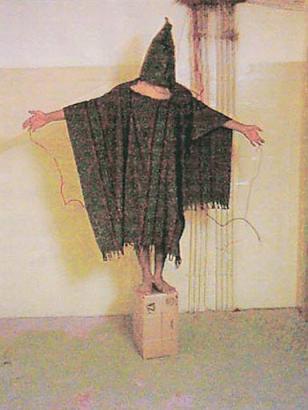
America has become a nation in which exceptionalists do what all they can do to destroy nationalism, eradicate the means by which the country can protect and provide for itself, but also the legitimate sources of national pride, sustainability and stability. In the corporatized, multinational schema, though the whole exceptional thing flipflops. "Buy American" is a verboten slogan, for example. The free market is placed before the Home of the Free, except when it comes to the practice imperial, international tyranny and terror on the neo-savages.
 The IMF's worst fear.
The IMF's worst fear.
I know, I know.
The unthinkable is normalized. Who would ever think that America would be a country for whom torture is legalized? Who could imagine the United States as a poverty-stricken place, where science is rejected and porn is ubiquitous? Who could envision a time when this republic would be enslaved by a cabal of speculators and banksters, willing to do anything, lawful or not, to acquire every bit of worth we possess? The truth is, enough people with enough power imagine America so to make it so. When enough people decide to reject the vision of bankruptcy - moral and economic - for America, it will appear as such.
 Mihai by Geoff Cordner
Mihai by Geoff Cordner
My old friend Mihai once told me the art world ran on money, power and sex. I've been reading Baudrillard's Forget Foucault:
>>
Desire is therefore only the molecular version of the Law. And what a strange coincidence to find schemas of desire and schemas of control everywhere.
<<
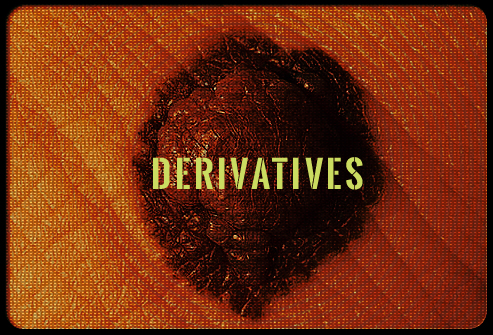 $1.4 Quadrillion & metasticizing daily (Paul McLean)
$1.4 Quadrillion & metasticizing daily (Paul McLean)
As things spiral out of control in Europe, because the derivative engine cannot be shut down, by the addicts for whom it addicts, or by the leaders who enabled the addiction to take root, and dream of when they too might suckle at its infinite teat, or at least suckle those who suckle, the wars of rebellion foment, soon to erupt, in spite of the militarized police. Eventually it comes to numbers, ratios and pressure. Sure, the West has been optimizing outcomes for small bands of professional soldiers facing hordes of enemies of Empire (remember the movie Zulu!), but the landscape skews when the savages are us and our relatives, and the soldiers their public servants. America's had a bloody Civil War and lots of riots and rebellions. We are aware of the consequences. RIP, Rodney King.
There's still time to choose a different route to tomorrow, and thus a different tomorrow. Destiny is no less original than fate is derivative, in the medium of choice. Of all the tools in the civilization toolbox, art is a good app for this. People who have experienced both warring and art-ing, those who have attempted such avocations as watercoloring and oil painting, but maybe also like a good action on rifle aimed at the enemy, tend to prefer art over time. Ask Winston Churchill.
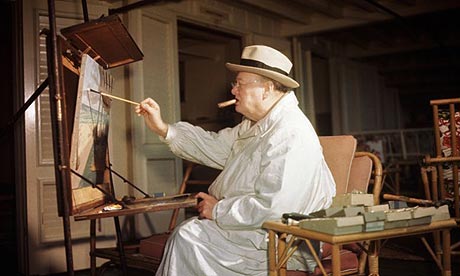 Churchill at the easel>>
Churchill at the easel>>
Armed with a paint-box, one cannot be bored, one cannot be left at a loose end, one cannot "have several days on one's hands."
<<
- Winston Churchill
 Army Joe
Army Joe
Mihai, you left out "war;" & what might art & war have to do with each other?
>>
...Thus will they always be one Revolution late. Or rather: they will await the Revolution to the very day, even though has already been accomplished. And when it happens, it will be because it is no longer necessary; it will nothing more than the sign of what has already occurred.
<<
(ibid)
 Bucket, Scott Ave.
Bucket, Scott Ave.
I had wanted to write a scathing comeuppance for Art in America's ridiculous art and activism issue (June 2012). What's the point? To attack the AiA's "New Realism" for what it is: a complete fraud:
>>
In a scene straight out of a Latino "CSI," the Mexican artist Teresa Margolles scrounges for bits of glass and gore following a killing on the streets of Ciudad Juárez, murder capital of the world. Her use of these grisly
"art supplies" at the 53rd Venice Biennale in 2009 wins her death threats from anonymous parties and de facto excommunication from Mexico's official cultural scene.
The U.S. photographer Nina Berman portrays Iraq War veteran Ty Ziegel and his wife, Renee Kline, in their wedding clothes. Showing a disfigured Ziegel and a dazed Kline, Berman's image exposes the real-life costs of war, and goes viral after appearing in the New York Times in 2007.
An Egyptian artist named Mohamed Fahmy, aka Ganzeer, is picked up by the police on the streets of Cairo in May 2011. His crime: pasting up a sticker featuring a gagged man and an Arabic phrase that translates as "Mask of Freedom." On his release, Ganzeer states his desire to paint a mural for each of the 800-plus martyrs to the 18 days of national revolt that began in January 2011.
The great Chinese rebel Ai Weiwei finally pushes his ongoing criticism of Communist rule too far. The regime demolishes one his studios and later detains him. When the artist emerges 81 days later—following an international pressure campaign that mobilizes the worlds of culture and politics—he shows little sign of quieting his very vocal dissent. As of this writing, he continues to harass the authoritarian rulers of China.
This is today's New Realism. In response to a host of global challenges ranging from political repression to economic crisis to endemic poverty and human rights violations, artists around the world are taking up pencils, brushes, cameras and iPhones to make art that connects with large numbers of people outside the system of galleries and museums. Despite living in far-flung locales and working in different mediums, these artists express a shared belief in the power of art to promote and effect social change. In the age of Facebook and live Twitter feeds, this conviction links them to a global audience that, for the most part, hardly follows the goings-on of the art world.
<<
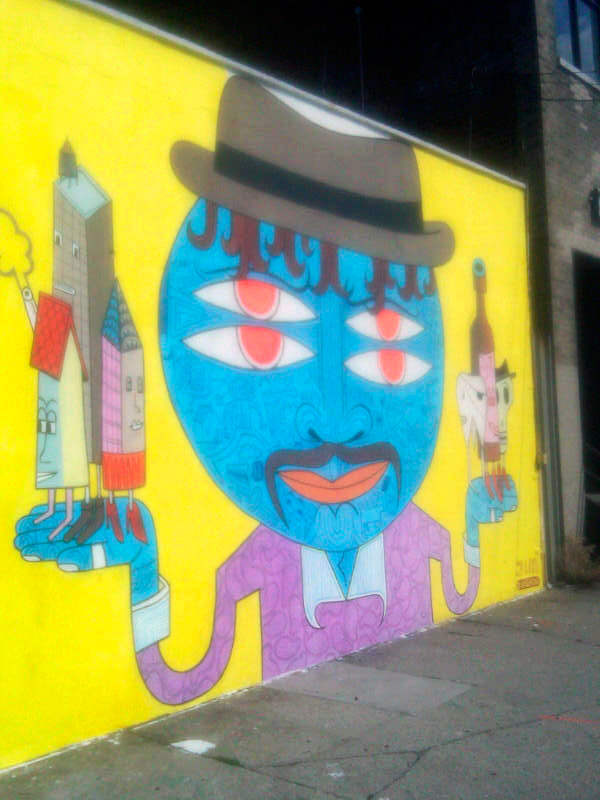 Bushwick mural
Bushwick mural
Milo's first reaction to the passage above: "This is nothing more than absorption; the sublimation of art and artist in the Big Picture, venting for the global neo-liberal + neo-conservative extraction-exploitation scheme, straw dogs posing as antithesis, revolution for profit and fame, and to sell ads, reification of real-ness and emotion (justificatiable outrage) in an artificial market for laundering blood money. What's the subject of resistance? Is it endless war and its effects, and the rest of infinite negations - or is what's at stake finitude, itself. Then, when does someone at Art in America confess that the art we have is not publishable in that magazine's pages. Is someone against this?" I told him to keep his ideas to himself. We don't want any trouble. Note there is no mention of OWS, but I think there is in the printed version, a debate of some sort, like those on Sunday morning on the television, maybe. I promise to pick a copy up soon, dear reader. Til then, I'm pissing in the dark.
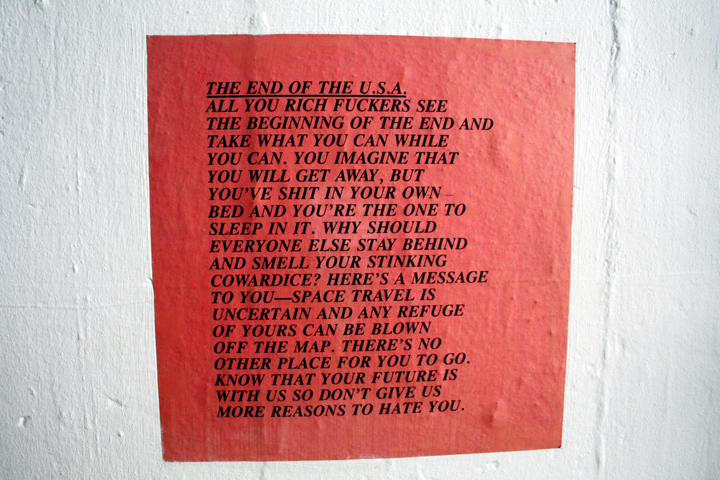 A sign at a Geneva art house (2010, Paul McLean)
A sign at a Geneva art house (2010, Paul McLean)
I saw that Carol Bove is featured on the AiA website. The Swiss have won the art world as surely as they have one the economy and "governance." {Q.: Is Ida Applebroog an activist? What is she resisting?} To paraphrase the protester chant: "This is what derivative looks like!" Meanwhile the IMF from Geneva is administering verbal spankings to the prime ministers of the Continent who might entertain the idea of forcing the hedgers and derivative billionaires to heel. The IMF bottom line on June 22?
>>
Recapitalizing weak banks—including through direct support from the European Financial Stability Facility and European Stability Mechanism resources—to address the adverse feedback loop between sovereign and banking stress at the national level.
<<
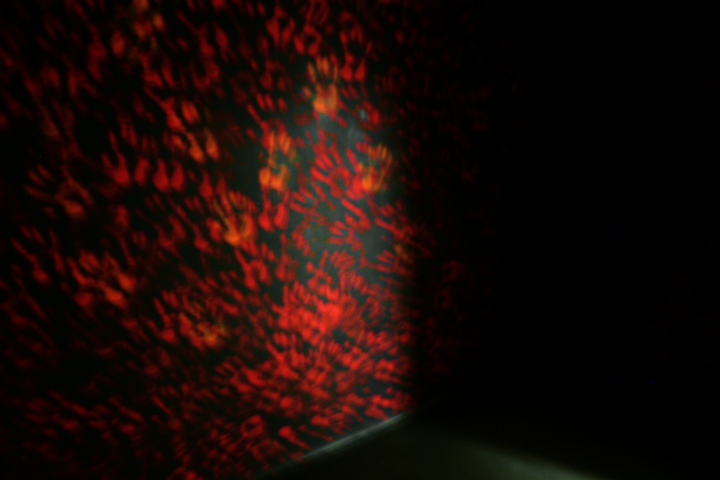 Installation, Geneva 2010
Installation, Geneva 2010
I won't cut and paste the entire transmission here (http://www.genevainternational.org/navigate.php?kind=1&id=145〈=en&last=55&lastsub=57), although everyone who's interested in either exorcism or alchemy should read it in full. Derivatives aren't mentioned once.
[PATHS]:
The method of beginning a process of detection without insisting on the solving of the crime is status quo in most police agencies. Many crimes are left unsolved, but open. Not everything today is criminal, but some of the grossest and worst crimes are not illegal. The authorities may agree that behavior in a given scenario may be immoral in the extreme, but then excuse their lack of action on the basis that no actual law has been broken. The authorities may also apologize for inaction, by claiming they do not possess the fiscal means or economic resources to pursue the criminals. Like everything, fighting crime is subject to monetization, now. Therefore, Law - and the US is supposedly a nation of laws - is in practice become a fungible, open-ended matter like every other line on the bureaucratic balance sheet. The giant sucking procedure performed by the derivatives market, extracting all value(s) from human endeavor, including national codes of law and, further, the agencies responsible for the law's enforcement, produce an environment in which the maintenance of a contractually legitimate society is no longer actual.
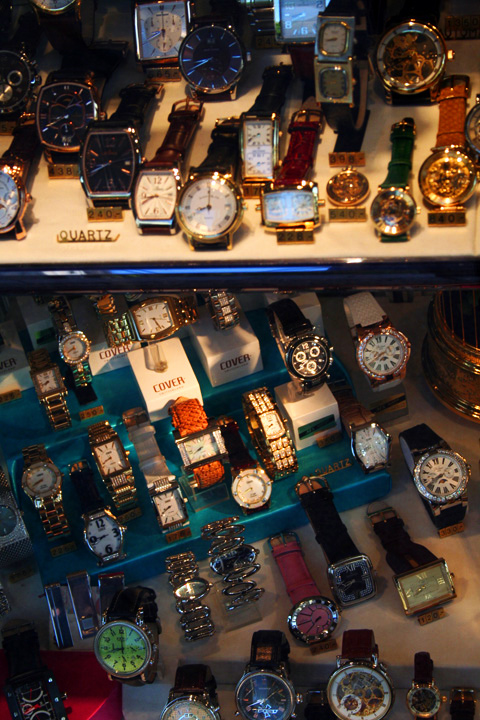 Switzerland, 2010
Switzerland, 2010
Our text will in one aspect mirror this status quo, in pointing out anti-social activities in the domains of art, media, etc., but then failing to solve or re-solve the crimes against humanity in play, or past. What does society do with unsolved wrongs? The unsolved crime is a sign of neglect, a symbol of lack (of resolve, will, efficiency...), a social management failure, to put it in the most banal terms. Derivatives exist as a massive complex of unsolved crime. The failure of society to remedy this crime, it could be argued, is the prime motivation of Occupy Wall Street. Although OWS famously has refused to reduce its meaning to one issue, and I would argue rightfully so, over time the movement has succeeded in at least reducing the blur adhering to crimes like the derivatives market. Matt Taibbi, who has of late worked with Occupy on campaigns, made appearances in support of OWS, while consistently providing through his articles and blog tremendous analysis and commentary on Wall Street's criminal culture and business, recently published another terrific account of lawlessness in the financial sector (http://www.rollingstone.com/politics/news/the-scam-wall-street-learned-from-the-mafia-20120620?print=true). How much more data is needed, to generate a major direct and dimensional response by Americans? Who knows? But if President Obama and the rest of the US leadership refuses to act on the accumulation of information pointing to justice, which is right measures applied adequately to wrongs, then why should any American artist feel compelled to produce right art adequate to life? The corrosion of civilization is possible to map by connecting dots among the nodes in a system, by virtue of the conformity of their questions.
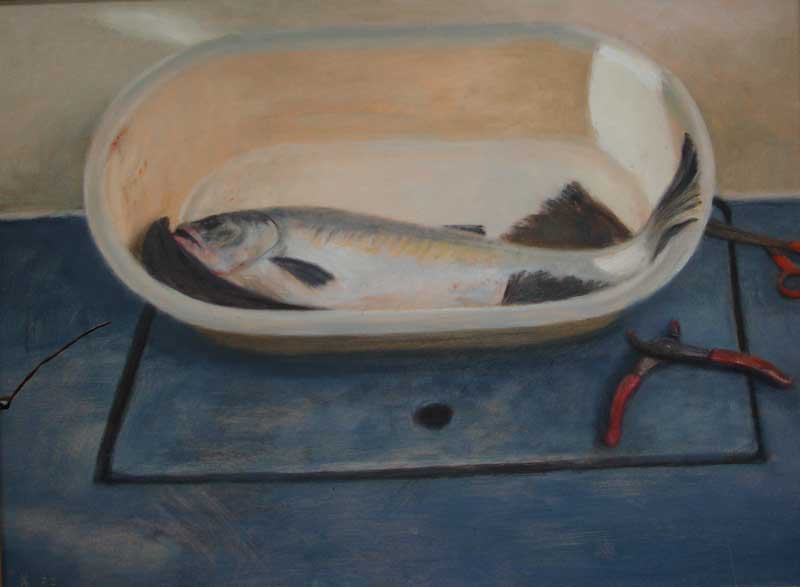 "Fish in a Bowl," Manning Williams
"Fish in a Bowl," Manning Williams
>>
Charleston native Manning Williams' work is legendary to many locals. His landscapes which often were gigantic were interrupted by his series of Indians. A series of narrative paintings tackling war followed. The past ten years finds a body of work based on cartoon format with abstract imagery filling the boxes and dialogue bubbles left empty. These vibrant stories without words or concrete images speak volumes about life and the viewer.
Manning Williams was born in Charleston in 1939. He received his BS from the College of Charleston before doing graduate work at the Pennsylvania Academy of Fine Arts. Williams’s work has been exhibited nationally and internationally with solo shows in Charleston, New Orleans, Washington, at the University of Pennsylvania Museum of Archaeology and Art and the Greenville Museum of Art. Group shows including his work were “Second Story Show” at Piccolo Spoleto in 2002, “100 Years/100 Artists, Views From the 20th Century,” at the South Carolina State Museum in 1999-2000, and “Old South, New South” at Winthrop College in 1995. In 2004, Williams and Linda Fantuzzo had a duo show at the Gibbes Museum of Art. In 2008, Williams had a solo show at the Florence Museum.
Williams has received a SC Arts Commission Fellowship. His most known commissions are displayed at the Charleston Airport and the East Cooper Hospital. His poster for the “New Figurative Painting” exhibition is included in “Fairfield Porter: A catalogue raisonné of his prints.” Williams produced the book jacket and illustrations for “Poems from the Scorched Earth” by James Everett Kibler (2001).
William’s work has been the subject of reviews and feature stories, and included in the video “Charleston Art Now.” His work hangs in public and corporate collections, among them the SC Arts Commission, R.J. Reynolds Corporation, Citizens and Southern National Bank, Post & Courier Publishing Company, Kiawah Resort Association, Greenville County Museum, South Carolina State Museum, the Gibbes Museum of Art and the Telfair Museum.
<<
- http://www.corrigangallery.com/mw.html
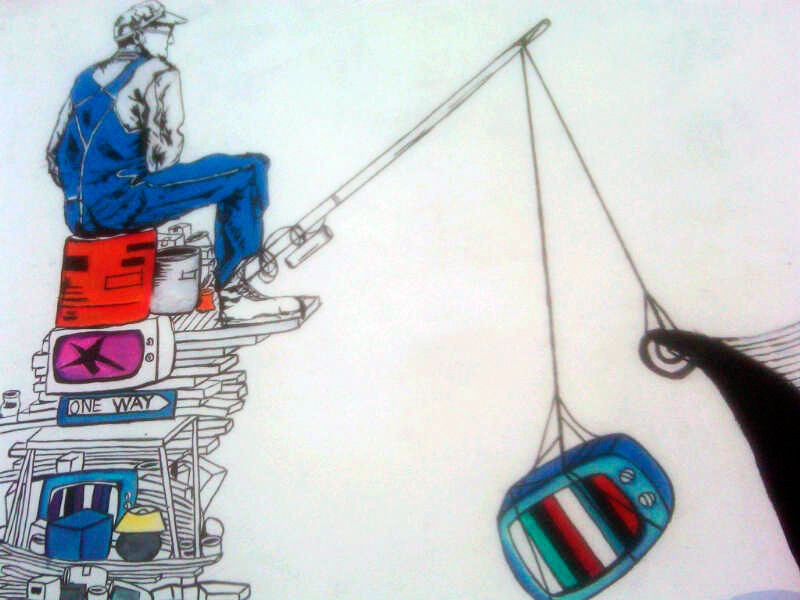 Mural, Bushwick
Mural, Bushwick
[INDICATIONS]:
Bushwick (open studios = "artist zoo") versus Berlin Biennial 7 (art world endorsed intervention = "human zoo"); (..."culture worker" v. "knowledge worker") > COMMENTARY > The subject of "art work" {see, or rather, don't see BRAVO's "Work of Art;" reflection on labor as a re-definition of art making or doing - the creation of art, folded into workerism doctrine} > The problem with labor movements is their bondage to artificial time-based production and productivity, which eventually is the root element in "human resources" or "- capital," alternative language for slavery by degree. Culture workers in their day jobs typically submit to the same time-cards for labor that every other worker does, more or less, which for them seems often to be the rub. Their pervasive dim view of artists could be derivative of occupational envy, which generally baffles full-time artists, who generally subsist in poverty. Hybrid Culture/Knowledge workers, who are part-time artists and part-time academics and part-time people - the curator - and they write for publication, too, again, do not afford the artist-only much space for co-habitation in the art topology. The economics of the phenomenon are fairly available, although seldom is the topic breached, except casually. Occasionally, a panel will appear, at conferences like CAA, to mull the scenario over. Those panels rarely contain artists. Desperation is the general subtext of these public airings. The papered graduate, and there are so many, each must secure a lifestyle commensurate with her ambition, which is subject to flux. Eventually, many of the culturati must migrate into other industries, in order to survive as middle-class citizens. It is no wonder so much regret and ennui permeate the blogs that contain open forums for complaints about the Dark Matter realities of the schema, which is degrading rapidly as a result of corporate-driven (hostile) takeovers of academia and all the traditional enclaves of sensitive, artistic, literary, perceptive spirits. It is a horrid humor that permits the Drucker Institute to claim that management is a liberal art, even as managers of all types of institutional mediocrity engage in the ruination of civilization, through strangling of institutions and free speech environments. (For amplification see the current scandal involving the gratuitous firing of a popular school president, unfolding at the University of Virginia, an academic institution founded by Thomas Jefferson, one of the pearls of public education in the United States, now managed by swine; or the systematic debasement of the vaunted Cooper Union, by a cabal of neo-Robber Barons and their lackeys... and so on.)
 Cooper Union Professors, Commencement 2012
Cooper Union Professors, Commencement 2012
>>
The main hallway of the Biennale is supposedly filled with a poster-making station, a radio station, and a “sleeping room” for Occupiers. According to Occupy Museums’ press release, the display has been called a “human zoo.” Writing for Afterall, Monika Szewczyk mentioned that some felt the meetings themselves were “preaching to the converted,” while others felt the “political force of the ‘occupation’ [was] completely annulled by its sanctioned presence in a contemporary art gallery.”
<<
- http://www.artfagcity.com/2012/06/18/the-berlin-biennale-adopts-owss-horizontal-power-structure/
∞
 Manning Williams' studio
Manning Williams' studio
I've a deep, if lighthearted animus towards open studio tours in general, which I have called "artist zoos" since I did one in Austin, that we utilized tactically for a bit of fun (at Rachel Korper's expense; which is kind of bad, because she's actually a very strong advocate for Austin art and has been for awhile now). I won't go into the details of that anecdote, except to say that my notations on Bushwick's iteration are colored by such experience. So, imagine my surprise when I learned that the Occupy (- Museums/Arts & Labor working groups') intervention slated for the Berlin Biennial 7, which was press-pushed as a hyper-political or meta-political art fair, was being critiqued as an artist zoo. I think the moniker was chalked up to wrong architecture, but still. I personally loved the idea that the GA process would suffer the scrutiny, be put under the microscope, that the arrangement seemed to create as an unintended consequence. I thought, "Share the misery!" Then, there was the update that the Biennial was responsive to critiques of itself emanating from the Occupy camp. Fantastic! You can't make this shit up. Looking at the photos documenting the Occupy-style gatherings, I felt a little nostalgic for a second. It passed.
 Peter Drucker, "A View of Japan through Japanese Art
Peter Drucker, "A View of Japan through Japanese Art
>>
The centre of gravity in production, and especially in manufacturing, then shifts from manual workers to knowledge workers. Far more middle class jobs are being created by this process than old blue-collar jobs are being lost. Overall the process enriches as much as did the creation of well-paid blue-collar jobs in the last hundred years. We do not, in other words, face an *economic* problem; nor is there much danger of 'alienation' and of creating a new 'class war' - the old bugaboos of Marxist rhetoric. Even among the groups that are hardest hit by the shift - American blacks, steel workers in England's Yorkshire, coal miners and steel workers in the German Ruhr - almost everyone has a brother, cousin, an uncle, or an aunt who got the needed schooling and has become a knowledge worker.
<<
- Peter Drucker, The New Realities
[Peter Drucker was horribly wrong.]
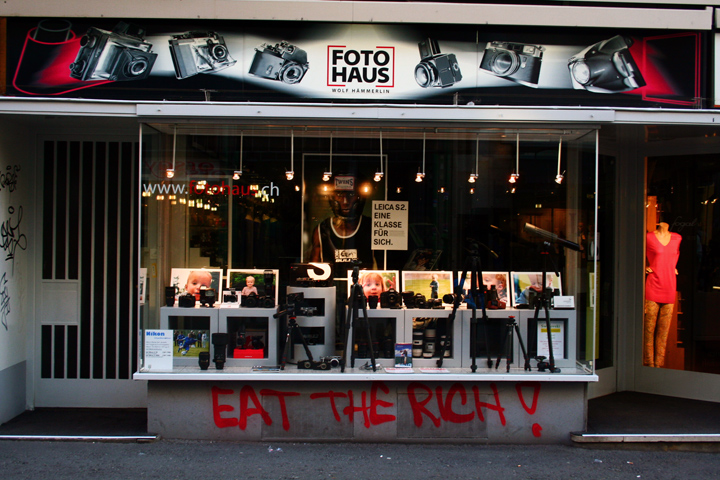 Street art, Basel 2010
Street art, Basel 2010
1
[CONTEXT]:
Yesterday was Flag Day, Dread Scott, which in New York City, generated less flag-waving than the National Puerto Rican Day Parade day last weekend. Anybody else wondering why that might be?
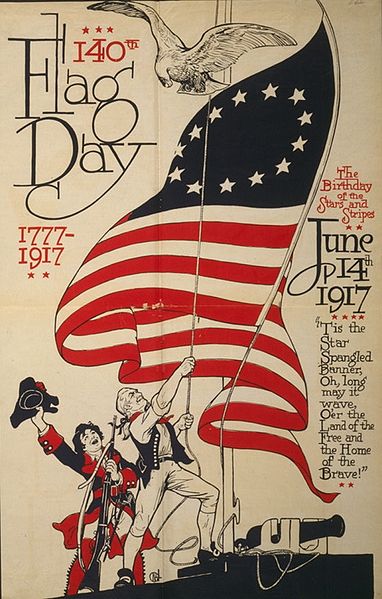
On June 6 - the 68th anniversary of the Normandy invasion (D-Day) - I was in Skaneateles, New York, with my wife and young child, staying at a spa with a simulation Monet garden. I rarely watch cable television, but the giant TV in our room permitted me that dubious luxury during our visit.
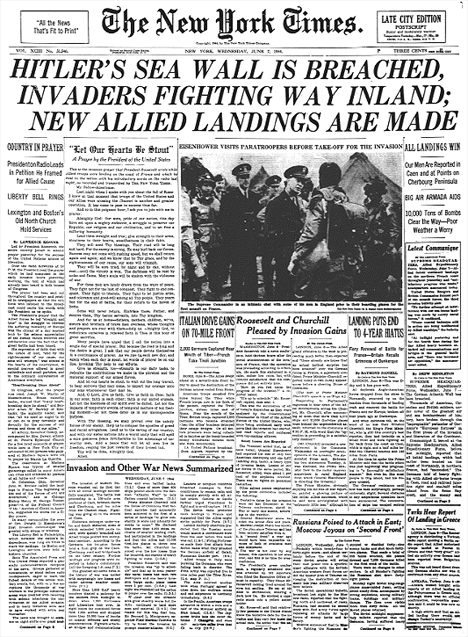
While the baby was napping, I would turn on the tele and search for commemorative programs, or even some acknowledgment, that 6 June happened to mark an historical moment for the United States and Europe, and I would say, the world. Nada.
 Click image to view the scene now, during the Voyage of the Hippo.
Click image to view the scene now, during the Voyage of the Hippo.
Actually, almost nada: FOX News, that quasi-criminal enterprise (see Cameron, News of the World), ran a short blurb. That was it, at least that was all I scanned over the course of my anecdotal analysis. I decided to double-check with TV by the Numbers. Nada. After a once-over glance at the regularly scheduled programming, my disgust was reinvigorated.
 Devil Anse
Devil Anse
One takeaway might be "Corporate media doesn't give a shit about American history." However, the biggest media story of the week, in terms of television ratings and viewership, was the record-breaking audience for the History Channel's Hatfields & McCoys, starring Kevin Costner and Bill Paxton, as "Devil" Anse Hatfield and "Ran'al'" McCoy. Now that's a story for this West Virginia native, and historical, too!
 From left to right: Ock Damron, "Devil Anse" Hatfield, Jim Vance, W. B. Borden
From left to right: Ock Damron, "Devil Anse" Hatfield, Jim Vance, W. B. Borden
So, the subject perhaps is a bit more complex.
 The Hatfield Clan
The Hatfield Clan
At this point, I should share with the reader my state of mind, as I recall the week, and some of the context for this installment of the "ENOUGH" series. The author was blue, bitter, morose. The Wisconsin recall results had demonstrated that the SCOTUS post-Citizens United ruling, democracy in this country is facing its biggest threat in seven decades. Worker rights are being systematically destroyed. No matter how closely one follows the arc, when a hinge point passes, such as Scott Walker's victory, one can still experience the moment viscerally. I did.
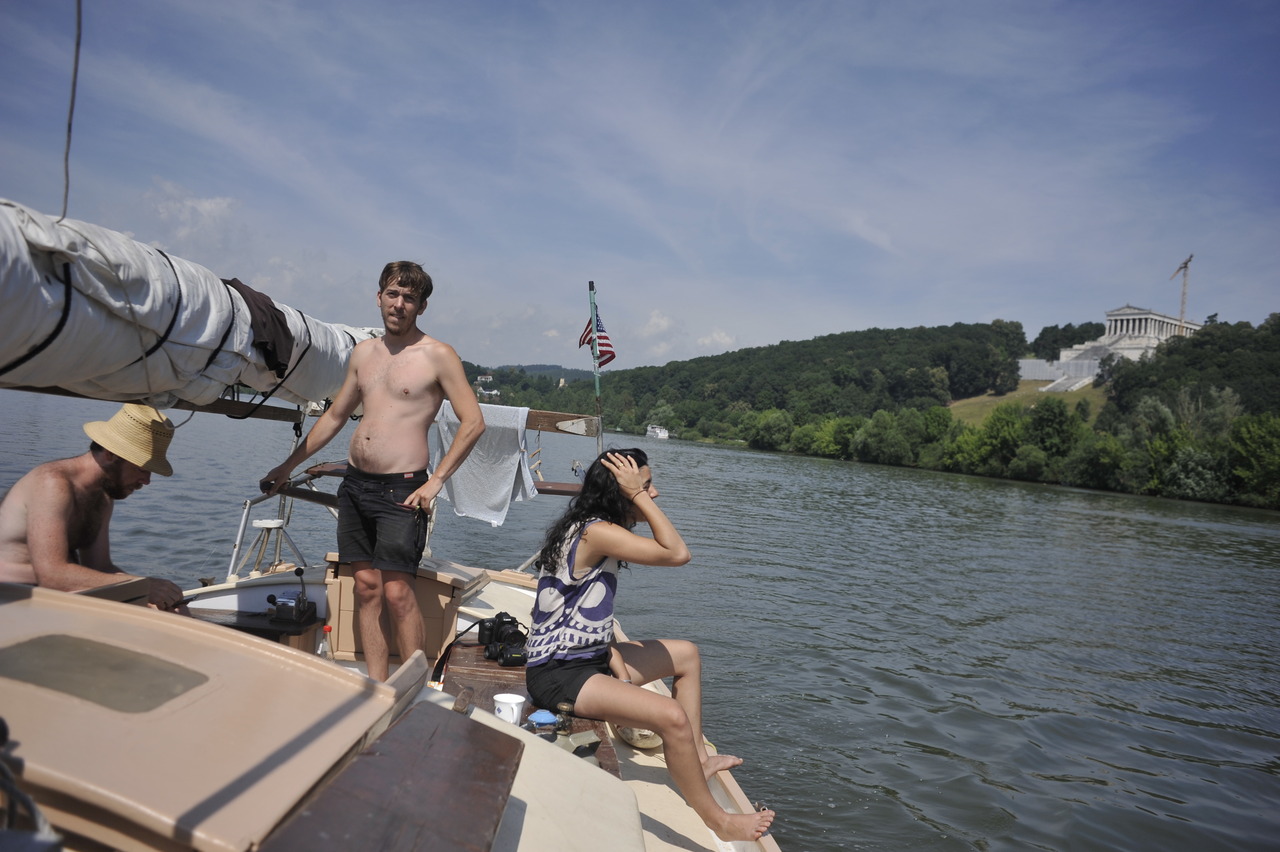 Sunny Donau, Walhalla in the distance.
Sunny Donau, Walhalla in the distance.
Then, there was the Spanish bank bailout a few days later. I won't write much about this astonishing turn of events here, except to suggest Paul Krugman's essay ("Another Bank Bailout"), and definitely the comments on the piece by NY Times readers. To summarize: another nation falls.
 The largest bonfire in Bavaria.
The largest bonfire in Bavaria.
The appearance of Jamie Dimon before Congress to give testimony on JP Morgan Chase's huge losses only serves to deepen this writer's existential nausea. If it weren't for the courage of the students and their supporters in Quebec and Mexico, if it weren't for the creative insistence of a few close friends and strangers, if it weren't for a new life close by and some reliable spiritual webbing, I might just say, "Fuck it," and either head to the hills, get a stable synthetic lifestyle, and/or commit to derivative art.
∞
Continuing our dimensional set-building exercise, for contextual references, which is what we're up to, we might peek at the status of the Occupy Museums/Arts & Labor intervention at the 7th Berlin Biennial. The actuality of the experiment, if that is what it has been, is something other than clear-cut, in the unfolding. Is this "an art," as Hennessy Youngman calls it?
 "unleashing the impossible imagination " [revGames]
"unleashing the impossible imagination " [revGames]
A related element or thread would be Nato Thompson's OWS Arts & Culture essays for Art Papers and Art in America. Thompson is reorganizing the historical narrative to prioritize a few working groups, I would argue, in a manner that skews the picture towards Thompson's anaesthetic views on art, artists and culture. I don't want to be coy about this, and artsy, on this topic. It's a flimflam job. Nato's version of early OWS Arts & Culture is exclusive, and omits and/or diminishes several features of the story that are essential. I do have a stake in clarifying the matter. One of these exclusions is Occupy with Art, and there are others - OM & A&L are hardly representative of OWS as an art phenomenon, primarily because these two groups are not art-productive, except in the totalistic parameters that Thompson advocates. Another is the *disappearing* or at least marginalization of the small band of revolutionary gamers who have quietly and consistently (continuing to do so even now) been the engine, the spirit of Occupy Wall Street Arts & Culture from its inception, and pop-op across its spectrum, over its timeline, at crucial junctures. Ultimately, Thompson's study of and recommendations for OWS A&C amount to partial erasure, driven by bias and perspectival prejudice. If it weren't for the degree to which OWS, with its Marxist and Anarchist core, already engages in systemic reformation as an internal organizational mechanism, arguably to its own (and our) detriment, Nato's confidence in re-orienting OWS A&C in the silo he defines for it, with the complicity of the art press, would not be possible. Despite the extent to which Thompson's review of the OWS A&C progression appears credible - he's a fine writer - especially given the minute constituency for it, speaks to the ideological status quo of the fractional society to which the essays are primarily addressed. The cliques of the academic, art critical art world and the markets served by it, those that read Art in America and Art Papers, are only too happy to accept Nato Thompson's rendering of OWS A&C, as such. If nothing else, in that medium, Thompson's story is viable as a confirmation of dynamics that prioritize discourse over both art and revolution, while safely linking institutional arts and culture to radical currency. Another potential effect, should Thompson's history be adopted as the historical one, involves authorial transformation of the meaning of the movement - as expressed through the many facets of OWS arts and culture, reduced to a few parts - into a proprietary *thing*, an object for facile parsing, deconstructing, ordering. Not only would that be a clear rejection of the principles that have driven the emergent OWS A&C, it would ensure that the resulting vision of the event be incorrect.
 Voyage of the Hippo
Voyage of the Hippo
I guess the question is whether "culture worker" and "artist" are reflexive or mutually replaceable terms. I've never met an artist who wants to be called a culture worker. I have met quite a few self-described culture workers - "culture worker" isn't actually a job description anywhere - who like to be called artist. This goes for a bunch of other people from a broad range of fields. Artists, for example, don't often express a desire or preference to be known as a mechanic, a plumber, an administrative staffer or a critic, except in jest or with irony - even if they work in these occupations to survive, pay for their art, or take care of their families. On the other hand, I've met folks who do these things for a living, pursue these occupations, who prefer that you call them artists, or at least, artists at what they do. Given the economic realities that most artists experience, it seems bizarre that anyone would want to be called one in public, in a society that places such a premium for self-worth on wealth production by occupation. The average artist is poverty-stricken, a pauper, and yet people from all walks of life like to think of themselves as artists. This is the odd flip side to Thompson's and others assertions about art as everything, and everyone's being an artist, and life and art being one and the same. According to such assertions, art is the immaterial composite layer applied by any practitioner of any form of labor, paid and/or unpaid, by the magical assignation of the critical theorist, media philosopher, systems analyst or immaterial aesthete (or the mechanic, plumber, administrative staffer, and so on). The mechanics of the occupational cross-processing for the vocational everything is, we should be able to deduce, no less metaphysical than economic, to say nothing yet of the political or social. Our confrontation of this complex illusion for now is barely historical - except with respect to Occupy Wall Street, by way of Nato Thompson and his experimental usage of OWS A&C to argue for compressing of all into it, and vice versa.
 Ambrose Curry loads a board, Kauai
Ambrose Curry loads a board, Kauai
Further, without linking to other historical contingencies - something Thompson does a bit of in his Art Papers essay - we can examine the platform of artificiality Nato works from, even though he is utilizing alternate terms and language. The "catch-all for a generation brought up under vast cultural production," as Thompson denotes it, as a life-art, artificial life itself - which is, according to the economics of everything (and thus systematic), a virtual double of actual life - needs an artificial art of everything to codify, or give meaning to, its artificiality, just as human life itself needs art for that purpose, and more. We are still rooted here, in the conjecture, in the human, even if only for an artificial reproduction of or replicant of the *actual* version, meaning us and our art. Whether or if we accept such madness as madness, we can run this program through its paces to generate conclusions about the formula it represents as a "reality," since the framework or architecture of the illusion is epistemological, as well as technical and pedagogical: as such, it is dimensional, and because it is dimensional, it can be mapped, without rationality as a necessity for comprehension of the operations involved. In the current derivative-distorted human condition, de-fining, compressing or reducing life within the contextualized, parasitic and imaginary scheme of power-to-dominate by the contrivances of ownership and/or more or less random valuation serving mostly the 1%, the illusion projected, and reframed by Thompson and others, is that life is as fungible as money, and therefore art, as a basic feature of human life, and must be subject to the same scheme, even if situated as a direct action against- or reaction to-. For the applications of theory, in their abstracting of everything human, as a reductive tool of intellect, the management apparatus conflate all with all to create an artificial One or Oneness, to incorporate the One, if not anthropomorphize it as a matter of perceptual expediency, to counterbalance the ever present, past and future One (that "Other" One). The latter One, the real One, resists, despite every maneuver brought to bear upon it by any- and everyone who would try, to accommodate subjugation by the Subject, of which critical theory is simply one amongst an infinite number of ones, or subjective, recursive, compressive and even oppressive ones-as-subject/object reproductions or displacements. The only object the One Object does not resist is art. Conflating art and life is a symptom of the very same psychosis that convinces man that he is God, all One, etc., and/or that he can buy and sell people, or anything they create. Or that he is free, when he is not. It is a memetic psychosis, to attempt to convince man to not make or do or be anything that can be bought or sold, or to make an illustration of the concept or idea that there can be no One, as such, that everything is derivative or contingent, or that defeat is somehow victory, when clearly it is not. Fuck that. Art is not a baby. On the point of the divine One, no person can know this anyway, whatever the truth is. I suppose it is presumptive to restrict the possible with such a statement, when we have a history of Saints to disprove the contention. That aside, Oneness with that One, however, and this is likely what the saints are getting at for us, is worth practicing in the blind, and we have much verification of this experientially, if not ontologically. The term "praxis" is a new stylization of this mode of conducting a life in action. Practicing *one's* Oneness on the Other, on the other hand, is where things start to get messy, or worse - and sometimes OK. It doesn't hurt to see where the evangelist helps the person in need, especially materially so. An act of kindness, whatever the trappings (and not the strappings), is always a fundamental human expression, even if it is not art, as such. Some behavior is, in times of need, as much or more valuable than art for humans. Food for the hungry is a precursor to the provision of art, I would argue. The ideologically driven reduction embodied by "cultural production" applies time-based productivity programming to an expressive act that for man predates clocks and the overseer, the manager, of Fordian manufacture, and the reactions that Capitalism's enemies contrive. The truth is the neo-protestants, the wannabe reformers of Capitalism's soul-/body-/mind- and earth-murdering and -maiming all-encompassing derivative matrix are themselves become as sick as the masters they seek to free themselves (and the rest of us) from, whether their motives are righteous, or not. They need a more generic iteration of Al-Anon, perhaps. Dealing with addicts, including those addicted to greed and its products or effects, will inevitably sicken those in contact or proximity with the addicted. Due to their obsessive attachment and enforced exposure to the monstrous in and of Capitalism, which at this point is an encompassing, sensory DDoS, and as such fairly unavoidable, the neo-protestants so infected are as effective at destroying art and its value with meaning as those for whom art is little more than an investment for-profit, a prestige-enhancer, or a means by which to disconnect the 99% from our human core (values and vision, meaning), the things that give worth to a life well-lived. The ugly art, the abject art, the immaterial art, the weak art of Groys, the utilitarian art of protest, and the rest, eventually abandon art's civilization-improving features and art's fundamental relation to mankind, its tribal essence, as a means to fulfillment in and connection with the world inside and outside us. Other-dissolving or reifying art only concretizes the falsehood that an Other exists. Whether the armature is psychological, political, sexual, racial or whatever, the reduction of art to content for cultural production and the artist to culture worker only serves as validation for the professional and amateur workers and entrepreneurs in what amounts ultimately as support fields for Capitalism, the non-profit array, established to deal with the wreckage and waste created by Capitalism's extraction and exploitation syndicates, over Time. A tax caveat and legal redefinition will never be enough for art and artists, and can never fulfill the promise art has for humanity. Somewhere along the way, over millennia, now, since Benedict established his corporate principles and rules for the monastery, maybe before then, it was forgotten that Time is the only Object, and everything else is a Subject, and subject to that fact. The evolution of propaganda for the transference of power to gods and kings and states and now corporations consistently tells the lie against Time and Object, against meaning and value, perpetuating the falsehood most any child can easily unravel. We and/or I have some choice in the rackets. We and/or I can choose not to play. We and/or I can also generate truly innovative - with the sense that new and now are intermixed - movements that insistently refute the illusion of false Oneness (promulgated by corporate syndicates, and all other 1% artificialities) by virtue of those individual &/or collective, dimensional movements resolutely not adhering to illusion, by being simply who and what they are. Be yourself. You'll make art. You're human. Do it with others. You'll have fun. You'll feel better. You'll be better. In Occupy Arts & Culture, the RevGames clan, the original OWS Arts & Culture group, get this better than any other fluid and motley crew in or around OWS since 9-17-2011, and just prior to the occupation of Liberty Square. Their Magic Mountain, their glitter bombs, bed-ins, toy protests, Novad salons, net-based communiques and a hundred other interventions and celebrations of life, freedom and art, including the banner drop at MoMA, in the face of staggering authoritarian oppression, stand as the most significant artistic eruption of the past 30-40 years. Nato somehow missed this. Unsurprisingly, so did the rest of the status quo art world for the 1%.
 Tuttle
Tuttle
∞
As with the above entry or causal episode, and the others we'll briefly introduce, for now, the reader is left to her own research. I will be moving through my own analysis, apace.
Holland Cotter's NY Times article on Bushwick Open Studios is a game-changer, LOL ["The Latest Vibe Moved to Brooklyn," June 7, 2012]. I had heard from several reliable sources near the Morgan and Jefferson stops of the L train that a Times reporter had made his way through the hoods. The morning after the D-Day non- or ana-anniversay, I read the review online, and marveled. Having visiting a few key fixtures in this year's BOS, like the Bushwick Basel, Sugar, the 56 Bogart spaces, and so on, I can comment on the event as an event. As a Bushwick artist-resident, I can also offer some local color. First of all, with respect to 4D, the best show I saw was Figure Fragments, presented by Coin Locker, a group show that shined as an example of how artists are driving the emergent Bushwick phenomenon from the bottom-up. I would also recommend the extensive coverage by Hyperallergic, which is not just now "discovering" the bloom in Bushwick, or presuming to ratify it. Hyperallergic, the Brooklyn Rail and Artfagcity have done yeoman work in documenting, celebrating and analyzing the trajectory of Bushwick, from urban junkie-/industrial wasteland of the sprawling Big Apple pre-gentrification sort, to the cultural it-disctrict for international art world attention-consciousness, a buzz-engine, gearing up with the ratification of folk like Cotter for a market lottery & harvest.
 Storefront installation, Basel gallery 2010
Storefront installation, Basel gallery 2010
Let's get real here. Open studio programs exist in places where a rational support infrastructure for artists doesn't adequately meet the needs of the artists grouped by location in communities, generally either far from art market centers, of which there are precious few in the US, or within driving distance of them, or in cities and urban neighborhoods that may qualify as creative class destinations, but don't support retail opportunities for their artists. Plenty of fine examples of open studio tours exist across the country. The one in East Austin comes to mind. Several in California and New Mexico also do well on their own metrics, and have done in some cases for decades. By now the phenomenon is national, mainly due to the absence of sufficient and coordinated Federal/state/regional/local arts and culture programs and infrastructure. Usually a few artists anchor the tours, or galleries, or studio buildings and whatnot. A centralized venue serves as host for opening night festivities, which typically include a party with music and plenty of libations, etc. Other versions of the form, such as Artrageous (1987-2010) in Nashville, operate as annual, seasonal, monthly gallery hops for culture-cause fun-seekers. They are often pre-fab contrivances that emerge from urban planning and revitalization campaigns, the bread and butter of Richard Florida-derivative consultant firms, working with beleaguered or ambitious municipalities. In such enterprises, art is a development utility. First/Second/Third/Fourth ____________(day of the week) art crawls fall into this category. Big corporate donors love to fund these things, attaching their logos to every banner and ad they can, reminding artsies whose booze their drinking, and, by extension, whose culture they're stumbling through.
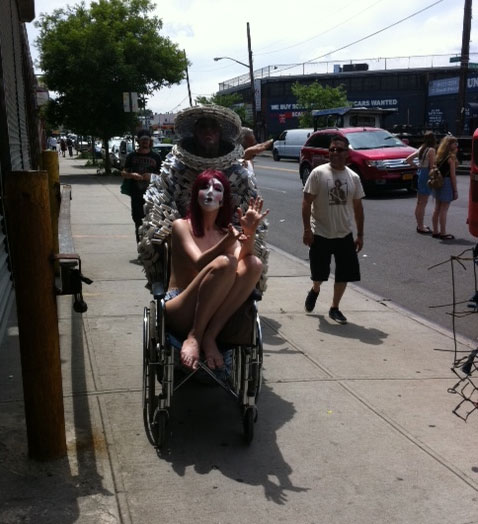 Bushwick Open Studeos [These two almost ran me over in front of Wyckoff-Starr Coffee Shop (photo/link: Artfagcity)]
Bushwick Open Studeos [These two almost ran me over in front of Wyckoff-Starr Coffee Shop (photo/link: Artfagcity)]
The bottom line is that America's lack of a public or commonwealth arts network, which has been left to the always-shittier "free market" (half-slave market), ensures that the nation's art and artists will continue to exist suspended in a state of disarray and precariousness, with a few bright examples or anomalies that are inevitably trotted out as proofs that the market is the way to go. Which is a big lie. Over the past couple of decades, what could be the world's best virtual iteration of a public, democratic and/or commonwealth network infrastructure was wasted, relegated to the private sector, which gave us E-bay for a while, and ETSY and some other mediocre alternatives. The massively important failure of the US government, to appoint the NEA and other agencies (humanities and education, one should think) to build an actual/virtual arts and culture network (a material-immaterial culture superhighway, ROTFL) is one of the worst administrative omissions of the era. Europe, pre-austerity, did a far better job than we did, and it showed. Oh yeah, but we did get the fucking global art fair syndicates. Which suck in so many ways that are now pronounced, and though they glitter, are little more than pig-selling by pimps and a primping circus of money laundering, on the whole. If one assembles the fairs and the even more morally putrid and corrupt auction syndicates, into a single pimple-like set, not neglecting to include those sycophants that drink their 1% sangria and eat the fishy eggs (brought round by artists in black and white uniforms usually), the pro-critical set making small talk and climbing towards the crumbs, performing their bits as jesters or eunuchs or wits at court, one can surmise the disgraceful bankruptcy of 1% art in a nutshell. The horrid excess of the 1% never exists in a bubble in man's universe, all talk of zero-sums and boats rising with the tide, aside. The main cost is to be found in what doesn't happen, while the 7 days in the art world repeat and repeat, forever more.
 Bushwick Open Studios 2010
Bushwick Open Studios 2010
Anyway, Bushwick Open Studios could and should happen every weekend of the year. Pretending otherwise, whether your argument is "common sensical" or ideological economically or whatever is just bullshit. The cool murals that popped up over the past couple of weeks in my neighborhood in Bushwick could and should be appearing all over the boroughs, including Bushwick, routinely. Little towns like Eureka, California figured this out decades ago, but the WPA AiA programs sorted this decades before that, in the 30s. Whole generations of American painters were deprived of the opportunity to do as Thomas Hart Benton and many others did, and represent the American dream in their communities, both urban and rural. The chance to forge ties among artists and their neighbors over than timeline was lost. The new and recent murals dotting the visual topology of NYC and its boroughs are not the output of sanctioned democratic artists, for the most part. They are either pop-up eruptions that are afforded few protections, "commissioned" by building owners who can't assure the artist or neighborhood that the next owner won't paint over the art, or they are marketing devices for covering up blight and improving the rents/seller profile or attractiveness of the neighborhood to renters who likely have no idea what the "on the ground" dynamics are of the properties they're considering, and so on. Most of the time, the mural in NYC is like a nice detail-job on a beater by a less-than-trustworthy used-car salesman.
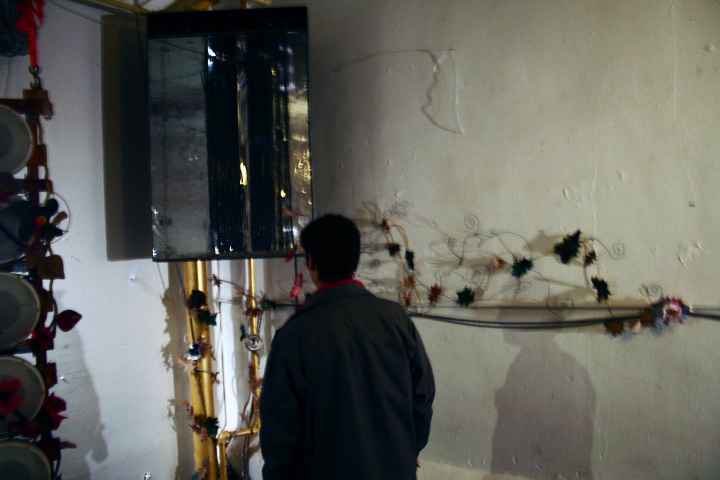 Bushwick Open Studios 2010
Bushwick Open Studios 2010
What I'm beating around the bush here is that all the funds that would enable America, which includes Bushwick/Brooklyn/NYC, to afford great arts programs, is being drained away by 1%-abetting mechanisms like the derivatives or hedge markets. The 1% art market doesn't give a shit about Bushwick, except on the pretense that it knows about what's happening here, and somehow suspected "it" would happen here before anyone else did, or can trace the lineage of Bushwick in such a way to give it meaning in a broader context, always framing a phenomenon like Bushwick as contingent on the 1%-centric nodes and overarching order. Fuck Holland Cotter and the Times. You wrote about BOS last year, too, about how MTA and Mayor Bloomberg for the third time in five years cut off the people's transport conduit Brooklyn from Manhattan, in effect torpedoing the event. You also wrote about Venice, or Roberta Smith did, infamously, almost a year ago to the day ("Artists Decorate Palazzos, and Vice Versa," June 8, 2011):
>>
The multiheaded beast of the Biennale reflects the hopes, dreams and decisions of thousands of individuals and organizations: artists, curators, museum directors and trustees, art dealers, corporate sponsors and a United Nations’ worth of governmental bodies and functionaries, not to mention well-heeled collectors from around the globe determined to raise their profiles with lavish parties, displays of their art holdings or both.
The rest of us just live in their world, trying to make sense of the spectacle of art, money and ambition they generate, taking pleasure and insight where we find it, which is as often in the city itself as in the array of artworks dished up for our momentary delectation.
<<
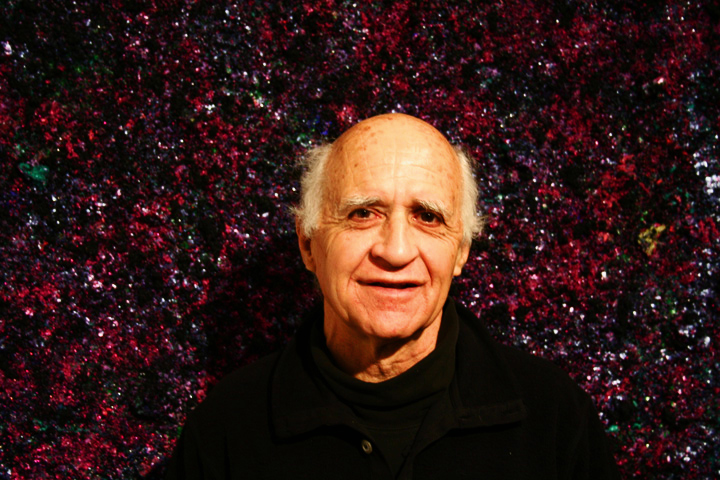 Art Guerra. BOS 2010
Art Guerra. BOS 2010
I said it then, and I'll say it again. Fuck Roberta Smith. I dance with a different hydra, and that one is alive and well and haunting Bushwick, today. It ain't Venice, but it stinks in the summer, too. Yo, Bushwick! Home of the studio of Hennessy Youngman!
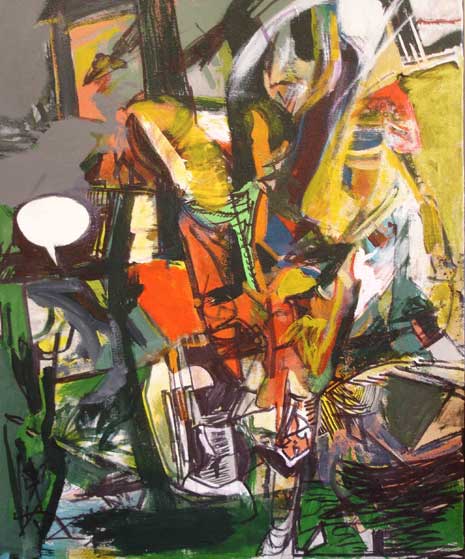 "The Red Cycle in a Field of Clover," Manning Williams
"The Red Cycle in a Field of Clover," Manning Williams
>>
At the turn of the 20th century, Charleston languished as an old Southern town that time had forgotten. Devastated by the Civil War, Charleston’s rich heritage hung over the city like a faded dream.
But in 1920, an amazing collaboration of artists and writers spearheaded a dramatic cultural revival that would last 25 years and help propel Charleston back into its role as one of the most significant art and cultural centers in America.
Drawing on an endless supply of subject matter, the artists of the period between 1915 and 1940, dubbed “The Charleston Renaissance,” began documenting the lush landscapes, plantation life, architectural landmarks and local color through their oils, watercolors, drawings and prints. The four local pillars of this era — Alice Ravenel Huger Smith, Elizabeth O’Neill Verner, Anna Heyward Taylor and Alfred Hutty — are also credited with inspiring Charleston’s preservation movement by reawakening the public to the charm and significance of the city’s architectural heritage through their images.
Even as Charleston continued to rush toward its cultural destiny into the mid-20th century, a young boy stood captivated by the miniature portrait collection at the Gibbes Museum of Art. Probably the finest collection of its kind in the United States, the miniatures were often commissioned on the occasions of births, deaths, engagements, marriages and other personal events, therefore revealing people’s most private moments.
“After seeing the collection of miniatures, I went home and immediately started sketching the faces I saw in the newspapers,” states artist Manning Williams. “So I was a portrait artist first.”
Born in Charleston in 1939, Williams was actually a skilled whittler by age 9 who could easily switch his work-in-progress from one hand to the other… an act he used to impress his fellow Boy Scouts. After graduating from the College of Charleston in the early 1960s, Williams toyed with the idea of taking a more traditional career path, but ultimately followed his passion into the world of art.
<<
- "Artist Manning Williams: Inspiring Charleston's Neo-Renaissance" by Patra Taylor (http://www.discovercharleston.com/arts-antiques/manning-williams.htm)
∞
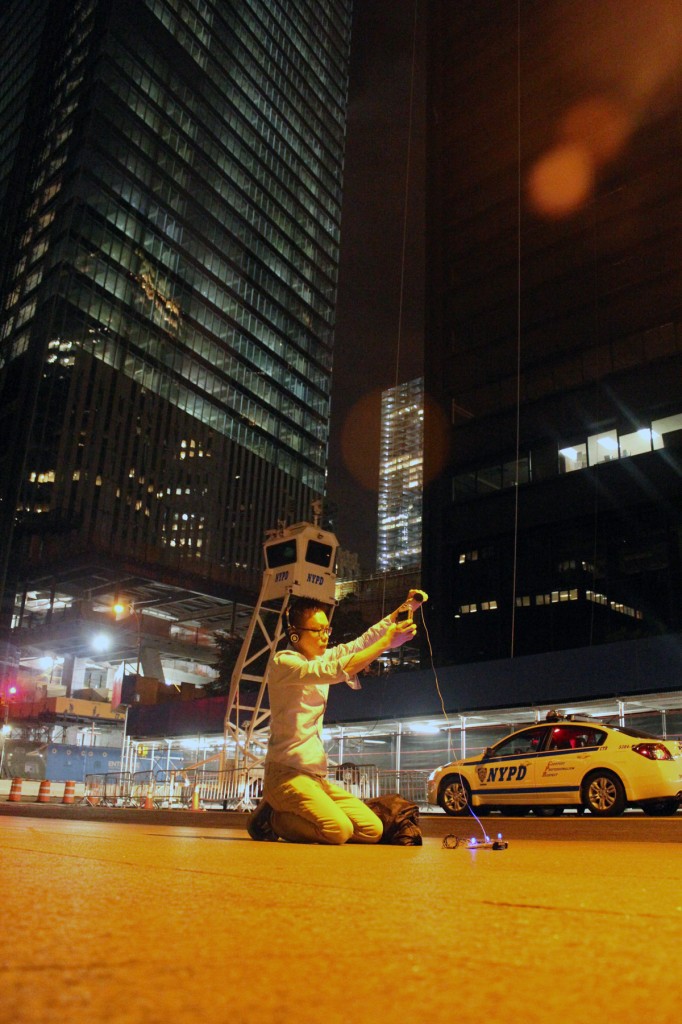 Taeyoon Choi
Taeyoon Choi
At the opening of "Code of Contingency" at 319 Scholes, the entry piece (on the rear wall of the back room) was a video by Taeyoon Choi. In the movie, Choi was sound sampling at Zuccotti Park. In the opening, Choi was mingling with the crowd, messing with drawings on the mini-stage at the foot of the projection. Some of the drawing were mounted unframed on the adjacent wall. They were very simple. There was a pile of gear over there. The room was pretty packed. I'm going to re-describe the scene below. I don't remember much about the other pieces in this group show.
 Choi, fiddling with gear on site at Zuccotti.
Choi, fiddling with gear on site at Zuccotti.
In the last entry, the use of "derivative" as a term applying to both art and the financial markets elicited a response questioning the connection, since the meanings are for art aesthetic and the other technical. Citing Choi's choice of location for his sound piece is meant to clarify the ties between the two domains. In the art world, which is now processing Occupy, the mechanisms for assimilation are tasking the normalization of OWS free radicalism. Think of an ice cream maker or a stone polisher, churning, turning. The output is sweet and smooth. The refinement of Occupy into an art, as Hennessy calls it, began almost immediately after the occupation commenced, with shows that deconstructed and re-situated the Occupy phenomenon as a subject for individual art praxis. One such iteration reformatted it linguistically, another conceptually, another performatively, and so on. Occupy with Art would often receive notices about these reformations from the artists, galleries, foundations, institutions and alternative art spaces, and fairly frequently artists or their representatives would attend Arts & Culture or OwA meetings, seeking endorsements, raw materials, authentic occupiers as participants, funding, PR, technical or logistical assistance, etc. The first out of the shoot was "No Comment," which eventually precipitated an internal organizational discourse on co-optation, but there were plenty of other less publicized or splashy episodes. Peggy Cypher's "Occupy Wall Street," a thing at Flux Factory that focused on the GA hand signals, something to do with sweaty tee shirts... The Gallatin/NYU show got a pass from the co-optation crowd - which befuddled the author at the time, given the intensity of the debate. Eventually, a fairly rational policy emerged on such secondary interventions in the Statement of Autonomy, but not without much intense soul-searching discussion, some of which was really was remarkable. It's important that the reader keep in my the atmosphere at the time, especially during the actual occupation of Liberty Square. Celebrities (JayZee was the most notorious example) were making appearances at the park, and some of them seemed to be using the occupation merely as a photo op, as a preface for swagging. Others seemed to be sincere in their expressions of support. Photographers from across the globe converged on lower Manhattan, taking millions of pictures. It was not uncommon for pros to attempt to schedule shoots in the mayhem of Zuccotti. Same with videographers and filmmakers. Songwriters penned anthems by the dozen and forwarded them to us, or came to the park to perform them. Law & Order famously created an alt.occupation set and was occupied by real Occupiers, disrupting filming and precipitating a surreal scenario involving actual cops and the temporary shutdown of the shoot, which eventually had to be relocated. MTV tried unsuccessfully to do an Occupy reality show. Artists from many countries appeared - one with a huge painting project to execute - attracted no doubt by the hype about OWS being an art movement, and hoping to make their art a prominent component in the wild visual mix. Chris Cobb's fake FOX newsman circulated through the occupation performing interviews and documenting the wild atmosphere and mix of people. Inquiries from press, arts organizations, individual artists, art material suppliers, and more, streamed into the working groups' cobbled-together communications platform. It was a mess, but a big, beautiful one, in a way. Months later, some occupiers, post-eviction, pined for those heady, nutty moments, with all the frenetic activity, intensified by the constant threats of park-clearing and police brutality, provocation or infiltration, the oppressive and aggressive surveillance schemes, and the daily dramas of negotiation with authorities and a generally opposing media. Eventually, in the weeks before the 2011 Holidays arrived, and meetings of A&C were still frequently held at 60 Wall Street, with respectable numbers of occupiers in attendance, the ersatz policy of OWS arts and culture for policing autonomous artist actions had pretty much congealed into a live-and-let-live attitude of openness, no doubt shaped to some degree by the post-eviction feelings of dislocation and concern about the diasporic future of the movement's creative wing. The phase that followed can be characterized as organizational evaporation. Now, the state of OWS Arts & Culture is ghostly, manifesting periodically as "arts cluster" gatherings and pot lucks, with a few groups continuing on their own, without any visible means of support from NYCGA or anyone else, aside from stalwart members. The run-up to the May Day action, long and single-purposed, situated Arts & Culture as a service wing of the protest, responsible for provisioning the action with color, a feeling of celebration, fun - prop-generator, march accoutrement, immaterial asset, sign-builder, performance or spectacle producer, propaganda designer and text writer, etc. No infrastructure development for a long-term A&C mission materialized in the process.
Jamie Allen
I attended the reception for "Code of Contingency," having heard about the show the night before at the EYEBEAM-hosted ArtsTech meetup, which presented a terrific program on conservation of digital media. I expected a messy gearhead-centric sonic hack installation, with some prints and laptops, a young crowd, and some heavy academia-enriched text, and that was all on view - the show structure and programming were better assembled than in my expectation. I made my way through the crowd and picked up a water and a copy of the cool fold-out poster-infosheet for CoC, and noticed that Jamie Allen, whom I'd met last summer at the European Graduate School was one of the exhibitors. I was getting excited, now, because Jamie is really good, and he also edits ContinentContinent, an excellent online webzine. Then I looked up at saw Choi crouched over the ground light array of Liberty Square - I get a visceral hit every time - fiddling with his little sound rig in the video projected on 319 Scholes. WTF, I thought, then I watched the movie through a couple of times, and was fucking disgusted and pissed. [Dear reader, I admit to emotional over-reaction. It was a genuine case of Occupy PTSD. I headed over to the Occupy R/x. The doc said, "Sign two petitions and call me in the morning... It helped to sort through all the meta-data...]

From the poster:
>>
Code of Contingency
(n.) The application of experimental sound practice to the ontology of code in order to learn from failure
...
Code
(n.) Any pattern of thought used to make meaning of the world; may apply to software, hardware, rules of laws, philosophy of science etc.
Failure
(n.) An event where previous systems of thought prove false and force an action; an impetus for learning
<<
 Call & Responce at Veolia LTD. ES CHP Heat and Power Plant, Lewisham 2011
Call & Responce at Veolia LTD. ES CHP Heat and Power Plant, Lewisham 2011
I'll add:
Contingency
1
(n.) Permissions one grants oneself as an "artist," or a curator/presenter applies in an exhibit or theoretical context both material and immaterial, actual and virtual, attended by an unaware or vaguely complicit audience, which ratifies "art" that leeches meaning from someone else's holistic experience, acting to neutralize the original and/or the cultural impact of the authentic, real phenomenon, thereby diminishing any potential inherent value or truth contained therein, consigning the original to the flattened domain of discourse, utility, abstraction, style, social "science," politics or technique, or some weak, pseudo-intellectual combination thereof
2
(n.) An aggressive act of neo-colonial co-optation conducted under the auspices of misapplied media philosophy, enabled by corrupt or vacuous aesthetics and aesthetes
3
(n.) Semi-professional media complement to neo-liberal globalist agendas for homogeneity and against dissent
4
(n.) False or fraudulent relations established, often achieving by conflating terms (especially nouns), fields of endeavor, events, etc., in order to prioritize derivative usage over originating action in a dimensional schematic
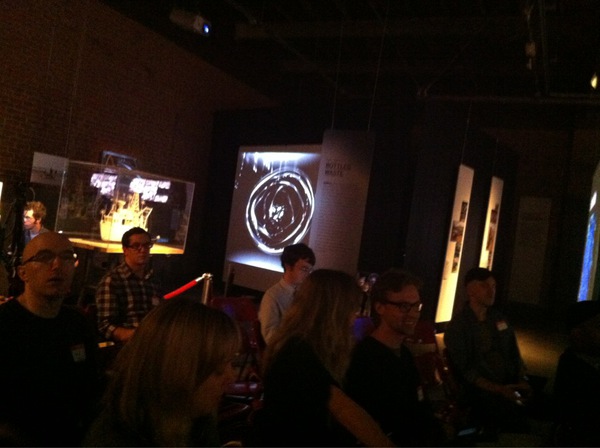 EYEBEAM, ArtsTech Meetup
EYEBEAM, ArtsTech Meetup
More [from Choi's bio]:
>>
Taeyoon Choi is an artist working with performance, handmade electronics and drawing in New York and Seoul. Recently he has been making simple machines to understand mechanism at large; urban space as a political apparatus. Thinking about the workings of social activism as part of the political apparatus, Choi released Noise Collector in Occupy Wall Street, proposing a dissimulation of the situation of activism. ... [workshop description >]: Choi will be revealing more politically charged aspects of the project in light of Occupy Wall Street movement, and in the wider context of recent international social movements.
<<
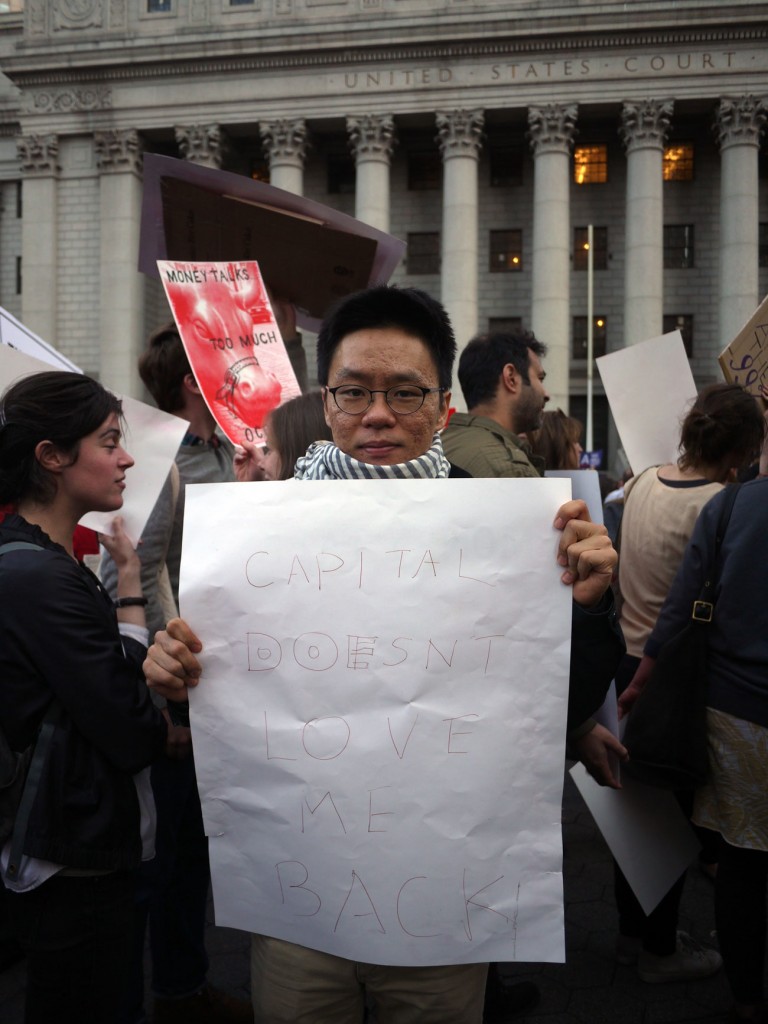
I'll add:
Taeyoon Choi is an electronic audio extraction engineer exploiting resistance as a cultural resource to give his experiments false currency, using terms like "dissimulation" and "situation of activism" he clearly does not comprehend.
More [from the show statement]:
>>
We see the world as series of interconnected events and relationships that are constantly changing -- the system. As humans we have invented an order, a pattern, a code, to deal with this ever-changing condition. What happens when the code breaks down and we are forced to invent a new one? This is the space that Code of Contingency occupies: the moment when knowledge systems' failures turn to a moment of speculation and education.
<<
319 Scholes has hosted some impressive programming, like "READ/WRITE," which featured the peeps of Jstchillin.org. Lindsay Howard and Igal Nassima and the other admins of the 3000 sq. ft. Bushwick space are plotting a cool path through the domain of experimental digital arts as a collective enterprise, featuring mostly young practitioners engaged in some pretty arcane trans-art forms, the sort of stuff that requires reflexive promotion and the creation of an alt.discipline to eventually merge into a wider cultural framework or audience, if that ever happens. "Code of Contingency" is not the kind of exposition that the 99% turn off the playoffs to visit. However, it's wrong to argue against what happens periodically at 319 Scholes, and in little nodes across the globe, conjoined by the web and mobile devices. Because the demographic of creative participants who devote themselves to the fabrication of DIY art-tech or net.art (or whatever the keyword is from moment to moment) is fractional, international and above whatever else rooted in a particular branding of geeky cool, the temptation to either apply hyperbolic expectations to it seems misplaced, if not futile. 319 Scholes could be an anchor space for the "New Aesthetic" that launched in March 2012 via a panel discussion at SXSW, inspired Bruce Sterling and others to tap out a wave of conjectures on what that might be, and then promptly dissolved as a pressing issue. The problem with all this is that the best and brightest of the up & comers, the vanguard of the tech-culturati, and the legions of users, a small proportion of whom are content-creators themselves, are tip-toeing around the elephant in the room, which is the derivative world outside that bubble. There are some important exceptions, like Mark Skwarek and Patrick Lichty, and the phreaks who brought their warez to Activist Tech Demo Day at EYEBEAM earlier this year. [Taeyoon Choi organized the event Occupy with Art participated in.] OWS Tech Ops certainly has accomplished some phenomenal work since last year, but I have found it increasingly disconcerting that techies and artsies did not and have not gelled behind Occupy, since they of all populations are empowered to fuel the fires of any generational revolution that will happen, if it is to happen, here in the US, and beyond. Since moving to NYC in 2010, I have navigated some of seams that are relevant or inform this discussion, such as Reading Group Number One, and the Internet/Media track at EGS, which attracts digi-luminaries like Sterling, Geert Lovink, Lev Manovich and the venerable, recently deceased Friedrich Kittler. Through these nodes, and others cultivated since the early 90s, and by making tech-testing and early adopting a habit, I have been able to scan and trace developments as they have emerged in the digital art field, in domains of print, moving image, graphics, net-based media and photography. It's important to recognize that the digital avant garde, which "Code of Contingency" and the programming at now more or less mature institutions like EYEBEAM, Rhizome/Art Base/New Museum, and others in Europe, represent, and which have art stars of their own, like Seth Price, Cory Archangel and Artie Vierkant, curators like Christiane Paul, Jacob Lillemose and Lindsay Howard, and solid gallery and museum networks for exhibiting, including the Whitney, new spaces like Stadium, and supporting venues in many university departments, even a marquee art fair, the VIP - add up to a small slice of a pie that's huge and getting bigger by the second. [See "Web Sites Illuminate Unknown Artists," by Melena Ryzik (June 17, 2012) http://www.nytimes.com/2012/06/18/arts/design/web-site-gives-artists-fame-in-times-square.html]
The evolution of the "new" art world has been coming now for two decades, although few people have followed it, as a phenomenon, even experts in the new media field that popped up in the late 90s as an adjunct to academic, market and institutional programs and expos. The reason is that the substantively subsisting establishment for digital art as it is, is dwarfed by other significantly more powerful interests who are pushing heavily to re-orient art into a new field of creative production. In large measure, the push over the past decade, post Y2K, has come from massive multinational tech syndicates like SONY. These corporations, including Apple, Google and Microsoft, are using their gargantuan capital reserves to systematically build platforms for hosting, maintaining and marketing bottom-top consumer-creator complexes, with both virtual and actual iterations. Through trial and error, many models have been tested to find the form that best suits the widest demographic possible. The goal, an industrial Holy Grail for the 21st century, is to seed, cultivate, harvest, distribute, manage and profit from a worldwide movement of computer-enabled creativity. The winner will monopolize the realm of digitized imagination, in order to fulfill a vision of comprehensive capacity to dominate it, control and thereby profit from humanity's immaterial enterprises. They want to own our dreams, thoughts, visions, aspirations, fears, whatever you like to call it, in the near-to-distant future. Kittler noted in a seminar I attended in Saas-Fee that Bill ("William," he like to say) Gates entertains a notion of people as "programmable matter," and claimed to have seen the memo in which Gates described us as such. It's important to note that Gates/Microsoft accomplished more than to convert ideas into proprietary material than anyone/-artificial-one. Unless you, dear reader, understand the big picture here, which not only encompasses macro economy, but global governance, international aid/education/health networks, etc., the tectonic cultural changes you are witnessing and experiencing locally will make no sense whatever. You won't have a clue about how to answer questions like: Why are museums becoming corporate showrooms? Why are the world's billionaires (like Bill Gates) devoting so much of their resources to destroying democratic public education and replacing it with for-profit versions? Why is the global industrial complex so intensely dedicated to dispersing manufacturing among third-world countries? Why is it so important that every woman on the planet have a cell phone ["A Cellphone for Every Woman," by James D. Wolfensohn (June 15, 2012) http://www.nytimes.com/2012/06/16/opinion/a-cellphone-for-every-woman.html and see also this proposition from the Innovation Working Group (WHO/UN) http://www.who.int/pmnch/activities/jointactionplan/jap_innovationswg/en/index.html]? You definitely won't grok what WEF/Davos means by "Shared Values" or its "New World Order." And you won't be able to see the connection between what's going on in the art world at institutions like LA MoCA, at art schools like Cooper in NYC, or on the micro-scale - as an aesthetic - in spaces like 319 Scholes, that function as nodes for innovation praxis attached to an essentially invisible art world infrastructure. They serve as a feeder systems, testing or proving grounds, CV-builders, exhibit circuits, meet-up hosts, fun labs, and most importantly, they facilitate the glocal exchanges for "emergent" creatives to refine their networks and platforms. Check out the overseas iteration of CoC, HERE, for amplification.
>
Crawling Taeyoon Choi's EYEBEAM NYC chronicle, I found another Occupy-related project. I think it reveals more about Choi's "artistic" use of OWS. Keep in mind the N17 action was the huge post-eviction rally.
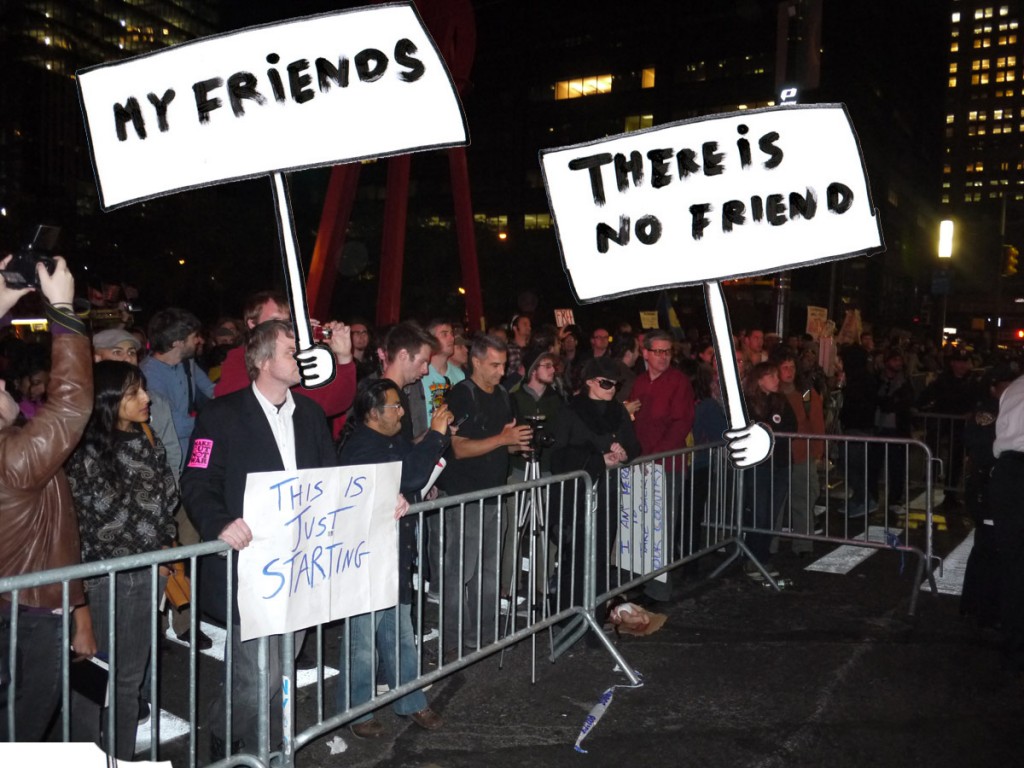
Text:
>>
On November 17th 2pm~4pm I will be at the Union Square and march For or Against friends and enemies. That day, a large protest/rally is planned from Union Square to Zuccotti Park as part of Occupy movement. I will bring two pickets that look like the drawings, one side will have ‘My friends’ and another side will have ‘My enemies’ and another picket will have ‘there is no friend’ and another side of that picket will have ‘there is no enemy’. My friends and my enemies, please join this march to question the conditions of democracy and politics of friendship! Our action and conversation will be documented by a professional photographer Jongchul Lee with audio by myself, which will be edited for my exhibition in Denmark, called “My friends, there is no friend”, some process is archived here. Video and photo will also be available online. If you don’t live in NYC, you can call me to have this conversation. If you want to meet me, please email taeyoon at eyebeam dot org to schedule a time between 2~4pm. Thank you.
<<
There were others.

>>
I have been having some troubling thoughts on the popular use of the word ‘democracy’.
<<
- Democracies exercise pad explanation
The EYEBEAM residency for Taeyoon Choi/the 319 Scholes expo and OWS are in a feedback loop. I don't think OWS new about this. [I wonder how many artists are developing bodies of work derivative of the movement that will be appearing in the art world over the next few months]. [I wonder if these artists mostly stayed autonomous from OWS Arts & Culture, so they could avoid the troubling thoughts about co-optation one consistently encountered at A&C assemblies.]
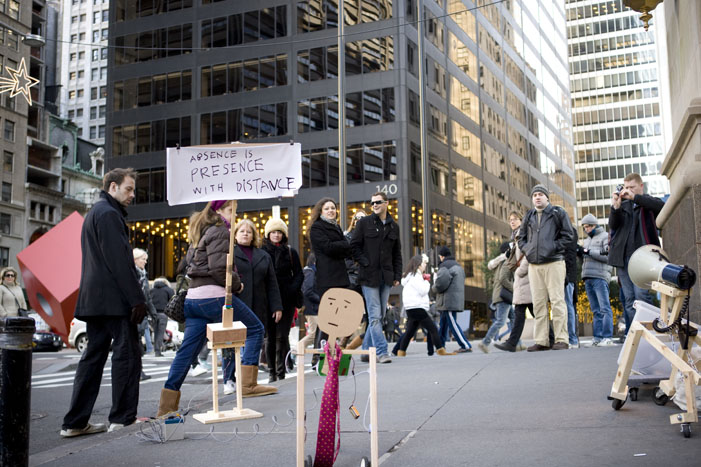 "Automatic Protester" by Taeyoon Choi
"Automatic Protester" by Taeyoon Choi
>>
‘Automatic protester’ is a set of physical tools designed support activists and eventually replace human from the protest scene. Learning from Occupy Wall Street and Arab Spring, it is clear that social movement is heavily mediated through new media technology. Similar technology can be used to enfoce hegemony of power and also as a tool for distributed collective action and participation. Government agencies are investing on artificial intelligence and unmanned vehicles to further control people in revolt. It is the time, we activists, to build practical and symbolic tools to continue protesting in the age of ‘non-human’ public space. The tools are built with material that will cohere with the New York City law for picketing, such as corregated cardboard, styrofoam and electricity will run on low voltage battery and solar cell. The series include ‘Occu-bot’, a hand made electronic protester that continuously occupies public space, ‘Noise Collector’, a dog that records and plays back urban sound via non-electronically amplified megaphone.
Up until this point, my work as the artist and lead engineer focused in creating working prototypes for art exhibitions, which I consider as a simulated public space, while it’s use in real protest scenes has been limited. The Rhizome commission will support launch of D.I.Y manuals to help others make their own and make a large quantity of beta versions that will be shipped to places of social distress around the world. The project website will exhibit videos documenting its use around the world tools. Around the time of public launch, I will hold a workshop for general public to make their own.
<<

STRING} : [AUTOMATIC PEOPLE][ROBOTS][HIVE MIND][KNOWLEDGE WORKERS]...[ARTIFICIAL PERSONS]
∞
[LEAP][VOID]
 Photo by Paul McLean, 2001
Photo by Paul McLean, 2001
The question of whether Occupy is dead or not is one that evokes other such questions about dead God and dead art. At the beginning of this segment, the epic was introduced as a "new" sub-narrative for Occupy and art. In past segments the reader was introduced to Ambrose Curry, and his amazing and beautiful World Travel Board project, as an example of itself. The latest transmissions from JezBold and Ale of the orginal OWS Arts & Culture - some from the G20 conference in Brazil (Ale) and others from [?] from Jez point to the evolution of spirit and consciousness via the movements and actions of individuals tied not just to the collective, but another something. Shane Kennedy is on a boat with a rotating crew of artists floating down the Danube. His most recent missives and posts will provide one answer to a question below regarding a reason for the D-Day invasion. Wilson Novitzki is touring with R. Stevie Moore through Europe, and we are exchanging music for visuals+stories, via Tumblr.
2
...Okay, so we're casting a big net, here. Fair enough. The stakes are huge. The big question is who will determine perception over the next 100 years? Who will have power over "hearts and minds" as humanity transitions into a 4D scheme that relies more and more on precise, massive and cost-efficient, time-based models of production, ubiquitous networked electronic devices, an effectively modeled and managed global market for developing, directing and exploiting consumer populations, enabled by coordinated energy, political, social, commercial, information and material resource matrices? The R&D wing of this operation will require the acquisition of pretty much the *entire* existing education/science academic infrastructure and the fabrication of an extensive network of new institutions form-fitted for the new global society. Why is Mike Bloomberg so passionate about his legacy campus(-es)? Why is Eli Broad devoting so much of his efforts in "venture philanthropy" to culture and education? To what end are Buffett and Gates of a sudden throwing billions at planetary health/education? The DeVos family? ...And these are only the high-profile 1%ers thus engaged.
EPIC.
[soundtrack, Law & Order "moment of truth" ambient] The value of "culture" in this campaign - and that's exactly what it is: [voiceover, Dr. Evil] a campaign to rule the world - cannot be overstated. Culture [cut-in visual, "Culture Club," "Do You Really Want to Hurt Me?"] is the key to the 1% managing to successfully institute global governance, to grab the instruments of planetary power, with a minimum of bloodshed. Minimizing bloodshed is necessary [fade in overlay, "Call of Duty: Black Ops], because the 1% have yet to garner control of the world's most powerful militaries, but that is changing rapidly. The process of privatizing force is accelerating exponentially over the past thirty years, and especially the past decade, post-9-11 [scene: WTC "jumpers"]. Co-opting and militarizing police forces is an important middle step [imagine ad, inspired by Rockland County (NY) Sheriff's website]. Privatizing prison and systems and judiciaries is another one [bump-in, scene from reality TV program "JAIL"]. Installing global surveillance and intelligence operations is another [see A&E, MI-5]. Acquisition of weapons manufacturers is another [...]. All these steps are being carried out in real time, with the complicity and through the corruption of government and quasi-governmental officials and agencies. The appearance and cultivation of mercenary armies (Blackwater), and the resurgence of industrial enforcers like the Pinkertons and Baldwin Felts, and others like them, all loosely defined as "contractors," point to the disintegration of national government-centralized citizen armies and the invention of a for-hire professional military employed by corporate syndicates serving 1% interests. Occupy Wall Street did a great service in exposing this development in New York City, and the same is true for the Occupy movement with its thousands of iterations across the US and abroad. The top-down coordinated crackdowns on occupations resulted in the revelation of how extensively the shadow armies of the 1% have integrated into the existing security infrastructure. Unless extreme measures are taken to stop and reverse this trend, civilization as we thought it might be will submerge into a radical, dimensional, globally encompassing social configuration that might be called "venture tyranny."
∞
 "Sailboats in the Harbor" by Manning Williams
"Sailboats in the Harbor" by Manning Williams
>>
“I consider myself a narrative painter,” states Williams. “Yet times have changed the way we see the world. TV, movies and the Internet pour out information faster than we could have imagined only a few years back. My work today is about finding a new way to narrate our times.”
...
Despite his numerous commissions, Williams’ role inspiring a new generation of artists may one day be considered his most significant contribution to the Charleston art community.
“I think one of the key things about Manning is that he has the ability to look at your work and understand where you want to go with it — and then he encourages that,” explains Linda Fantuzzo. “He’s unlike most artists… they seem to want to grab you and get you to do what they do.
“Manning is an artist’s artist,” continues Fantuzzo. “His passion for art and art history, and his work ethic have been enormously inspirational to me and to his other students. Not only has Manning been generous with his knowledge, he’s also been generous with his work. The eternal optimist, Manning is my best friend and greatest mentor.”
<<
- (ibid)
 Mihaly Csikszentmihalyi
Mihaly Csikszentmihalyi
To identify the essential tools in the tyranny-enabling creativity complex isn't tough (thanks to Google and Wikipedia). Creativity is its own industry, with stars like Richard Florida, Sir Ken Robinson and a progenitor, Mihaly Csikszentmihalyi. The creativity industry has its lobbying firms and foundations, like the Curb Foundation, headed by former NEA chair Bill Ivey and attached to Vanderbilt University. It has its metrics generators and its methodologies (e.g., "Attribute Listing, Morphological Analysis and Matrix Analysis") and consulting programs. The buzzwords - "creativity" and "innovation" - have been normalized and dispersed through the corporate, governmental, social and educational sectors, and subtly or explicitly linked to programming that advocates synthetic or syndicated globalism through a multitude of directional approaches (local>global, and vice versa, by- or trans-sector). High profile pundits like Thomas Friedman cheerlead for innovative global solutions. Interdisciplinary programs like NYU's champion internationalism, or even more, the dissolution of nationalism. At every turn, in economic and political circles, popular nationalism is fretted about and warned against, with great admonitions against protectionism. The World Economic Forum, TED and other conferences showcase the medium.
How is all this creativity working for us? In the United States, the past several decades has seen the destruction of a national economy, and its replacement with a consumer market for the same goods we used to produce here, which are now produced in China, India and elsewhere in what used to be called until very recently the Third World. Management ideologies supportive of outsourcing, de-nationalization, de-centralization and the transformation of the West's populations into consumers and "Knowledge Workers" have been shaped into globalist dogma by gurus like Peter Drucker. The current crop of creative destuction/management fanatics, some of whom occupy in the highest offices of our nation's Capitol, and by extension, the world's most important economic institutions, like the ECB, are employed to defend "global solutions," as if everything a technocrat, or politi-corporate hack applies to problems is creativity in action. In fact, almost every policy proposed from the top-down is a con disguised as homespun moral certitude. Now, that's creative! Through a jaundiced lens we can see that, for example, austerity is a cost displacement program, for re-allocating losses incurred by speculators to public financial institutions, or private institutions insured by public funds. The Wars on Terror or Drugs are socio-political boondoggles that create great human suffering, disenfranchise or marginalize entire populations (don't say "genocide"), incur nation-staggering fiscal displacement, corrode moral and ethic codes (see "enhanced interrogation technique"), and make a few people and corporations unimaginably rich, over time.
"Creativity" is a smiley face on Tyranny. It's about as authentic as "Corporate Social Responsibility."
Before moving into on the oblique to another sphere, I'll wrap up the intro to "creativity" and derivative art, as they exist as cystic particulates in the macro organ or exo-derma-shell of the evolving command-control complex for the extraction-exploitation syndicates. First of all, Lady Gaga, even in the kiss-sign with Mayor Mike Bloomberg, did not conjugate the creative complex with Bloomberg in his/its manifold iterations. The real agents in the war on humanity have no problem discerning a pop star diva from the head-of-state or -principality, when it comes to getting what it is they're after, whether that might be concessions on real estate development, taxation or industrial subsidies, military or police protection, waivers for projects, de-regulation or tactical position-enhancing regulation, or political cover, etc. Second, the competition for the senses of the masses is hardly separable from the industry that appears to mine the mass for statistical and other data to confirm or deny whatever position or policy 1% syndicates prefer. Third, there's a reason why Warren Buffett is buying newspapers by the bushel, now. Fourth, President Obama's appearances on "The View" or acceptance of the Nobel Prize for Peace have done nothing actual to increase either access to him for the "regular citizen" or deter him from pursuing war, assassination, torture and other aggressive, violent and destructive avenues since he assumed his office. The creative, apparently, only goes so far.
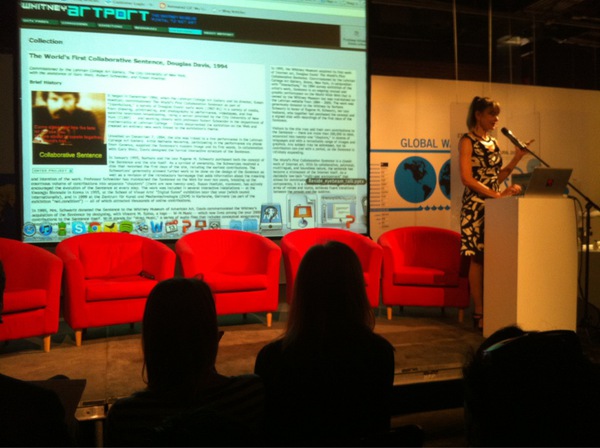 Christiane Paul at EYEBEAM
Christiane Paul at EYEBEAM
[SUBTEXT (for transparency purposes/connecting the dots)]: Ongoing background development & research} ...Speaking of Tumblr. I met with Annie, an artist outreach specialist at the dot com phenom at 71 Irving Place for a coffee, to talk about potential collabs and such. I sat next to Annie at the EYEBEAM-hosted "Digital Conservation and Archiving" #ArtsTech Meetup (Tumblr was a sponsor). I also met the phenomenal Lindsay Howard at the meetup. I learned about the 319 Scholes' CoC opening via Lindsay's Twitter feed.
 Nsumi @VAV
Nsumi @VAV
Before I forget, I wanted to mention James Andrews/Nsumi Collective's cool workshop at The Vis-á-Vis Project's Night 2 @Brooklyn Fireproof. I only caught the last few minutes of the collective-vision-praxis portion of the program, having just made it back to Brooklyn from Skaneateles that evening. I joined one of the circle-groups, and a dancer from Oklahoma (who was going to be performing shortly - she and her ensemble were really fantastic, by the way) proposed as our big idea an art-Olympics, which was adopted by the team. I was astonished at the conceptual echo or synthesis with the revGames concept, Revolutionary Olympics, which had popped up only a few weeks prior to the Nsumi brainstorming exercise, and since apparently dissolved into the medium of the game. Another one of the groups in the presentation phase of the workshop shared an idea that sounded just like Wall Street to Main Street & CO-OP/Occuburbs mashed up into one big idea, another instance of echo/reverb phenomenology. James and I discussed it afterwards, and high school portfolios. I also had a chance to congratulate VAV co-founder Rachael Pazdan. What a fantastic surprise! The Village Voice says VAV is the “next step for do-it-yourself culture.” Go SUNY Purchase!
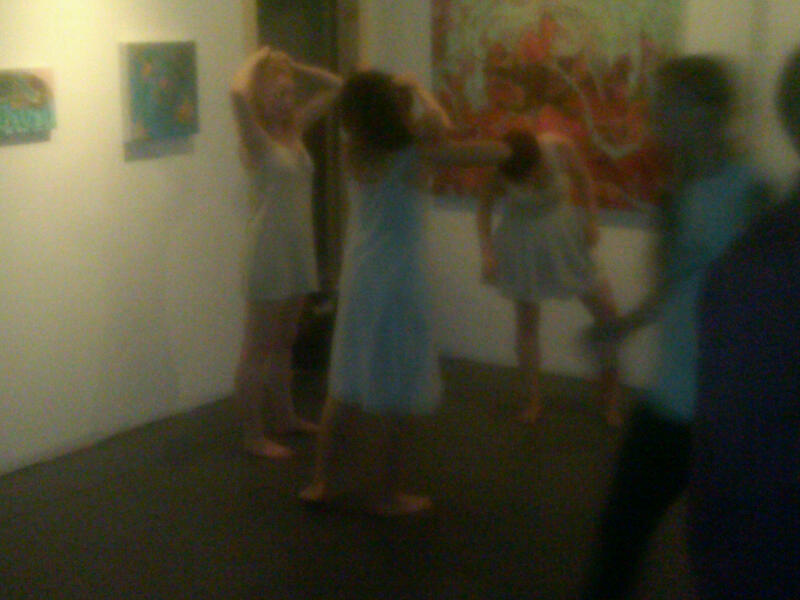 Dancers warming up at VAV
Dancers warming up at VAV
I've started about 30 tumblelogs since spring 2009. Ben Valentine of Hyperallergic recently conjectured about the Tumblr as a vehicle for art. One of the featured artists using Tumblr as a medium was Reading Group Number 1's Brad Troemel. Through several threads I caught up on the rising star of RG1er Artie Vierkant, who has a show in Chelsea and curated another. He's been in about 20 over the past year, according to Paddy Johnson's article in the L Magazine.
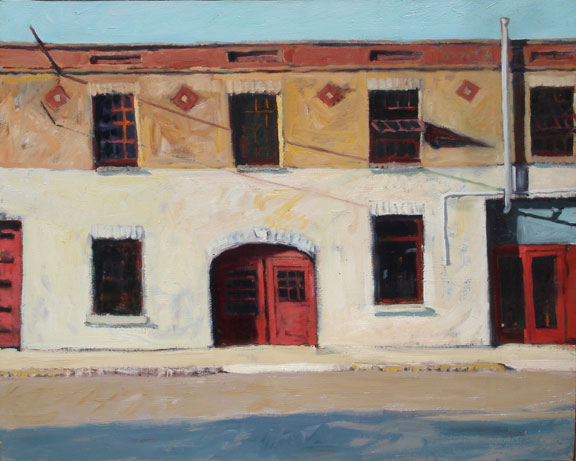 "Sunday Morning," Manning Williams
"Sunday Morning," Manning Williams
Paddy's being sued by an "art authenticator," along with a bunch of art world notables and press vehicles. Is "art authenticator" possibly a profession in this world of art, today? I would love to meet this person! What is "authentic" art?
∞
How does the consolidation of perception operate? Once the imagination or vision is reduced to "content," the process of integrating idea-objects into exchange networks is a fairly routine matter. Since content is now derived from "home studios," meaning some part of the house with a computer and modem plugged in and sitting on a desk or other flat surface, or a "production house," meaning several rooms, or a bunch of desks or tables in one room, usually supplemented by a small kitchen and a conference area, with 4-10 computers and a fatter internet connection, only a couple of types of pipelines into exchange networks are necessary to channel content from content-creators to the secondary or assembly location. Often the tasks of content-creation are bundled, and even bigger bundlers finish prep for output and complete output. The finished product is then stored and shipped, or built to spec or customized, then shipped via a business that specializes in the distribution end. As the processing of content creation continues, digital industrialization matures, and the monopolization of the industry minimizes anything extraneous from the procedural progression from idea to consumer portable, the creative resembles every other product thus "refined." It takes on the qualities of cheese whiz. Entrepreneurs expand and mold their creative industrial arrays mostly through acquisition. We have seen over the past couple of decades all those DIY communities, of which there have been many, exhibiting a diversity of focal interests, from games to photography, autonomously forming ersatz international collectives, some of which are huge, subsumed into a unified field of creativity+entertainment industries, eventually maturing into global utilities for cultural production, including what we now characterize as the "educational."
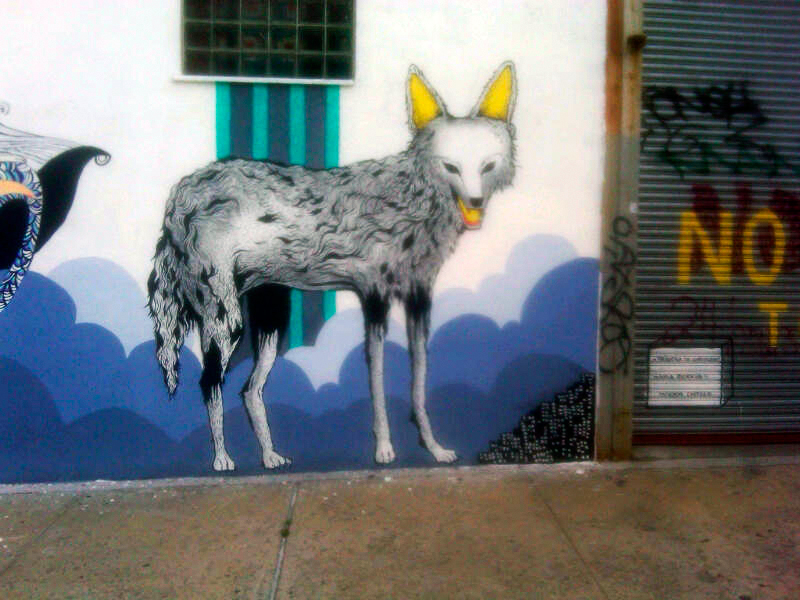 Mural, Bushwick
Mural, Bushwick
And, as a society, we have not much to show for all this change, adaptation, movement and "wealth." Lots of comic book movies. Teenager-friendly dance songs about bad romance. Books about murder, or by Right-Wing pundits. Sports action figures. A few genres. A few big box outlet stores. Some games. Housewife reality TV shows. Magazines that are filled with pictures of nothing much. Actually, all things creative in the innovative creative are metrics of Lowest Common Denominators and ROI. Mass media and mass become one and the same only in their reduction to numbers, either for evaluation or cost or wealth-production value, all of which move on short-term directional vectors in systems that see themselves (as in AI, artificial personhood) on infinite feedback loops. The creative artificial, the plastic art, is an enumerated iteration of Hell. Real people, doomed to this perpetual cycle of manufacture, use and disposal, after undergoing dimensional compression into fluid roles as users, consumers, producers and critics, are reduced to mass, programmable matter systematically.
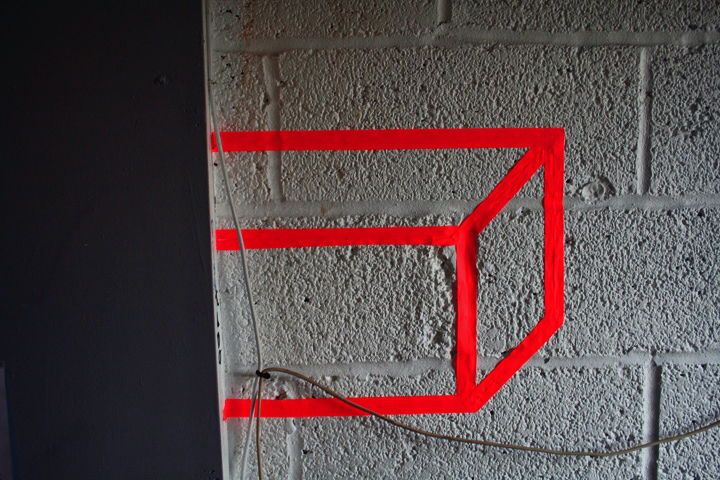 BOS 2010
BOS 2010
It doesn't help that the world's most powerful government officials have signed on to the program.
>>
Meeting the desert scrub of Mexico's Baja region in an effort to lift the sputtering world economy, the leaders of the so-called Group of 20 eschewed specific commitments, instead limiting themselves to more generalized promises to invest in public works, overhaul labor markets and use innovation, education and infrastructure investment to fuel economic growth.
<<
- "World Leaders Make Little Headway in Solving Debt Crisis" (NY Times, Helene Cooper, June 20, 2012)
 BOS 2010
BOS 2010
No mention of derivatives in this article, but lots of talk about debt, austerity and the recession. No telling what "public works" means - maybe "war." "Overhaul labor markets" means destroy unions in the West, and pensions. "Innovation" and "education" is discussed above. "Infrastructure investment," at least in the US, involves pumping billions into police/surveillance/prison state industries, including on the back end of the internet, with the help of Google, Facebook and the telcoms, and others. The word "creative," among the many encoded phrases and words injected into this technical transmission dispersed through the Times, does not appear. The article ostensibly is focused on Serious issues, being worked on by the world's most Serious individuals, representing the planet's most important nation states. Obama, supposedly occupying the most powerful public station on Earth, is characterized as a "bystander...little else."
Creative is what the 99% will have to be to survive the messes these people are managing to fail to address effectively, in their jobs as managers of the masses.
 BOS 2010
BOS 2010
3
>>
When they came into the garden, they ran hither and thither, and picked armfuls of flowers and greenery - they had never set eyes on anything so lovely. At last they couldn't pick any more, but just as they were to go inside again, they caught sight of a big rose at the other end of the garden. It was far, far lovelier than any of the the other flowers they had found, so they simply had to have it. But at the very moment they leaned over to pick the rose a big snowflurry came, and they were gone.
<<
- Norwegian Folk Tales, Selections from the Collection of Peter Christen Asbjørnsen and Jørgen Moe ["The Three Princesses in the Mountain-in-the-Blue," (p. 33)]
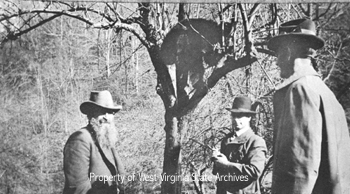 "Devil Anse" with two unidentified men and bear in tree
"Devil Anse" with two unidentified men and bear in tree
In our spa haven in Skaneateles, where American flags abound, and the Rotary Club celebrates Father's Day with a pancake breakfast, I watched the entertaining and fairly accurate TV miniseries Hatfields & McCoys and wondered at the number of commercials wedged between each sliver of content. Isn't the FCC supposed to regulate the ratio of content to ads? Having been raised in southern West Virginia, and knowing a fair number of Hatfields, and being familiar with the feud by art and association, I had mixed feelings about the translation of that history into the popular consciousness, via the format of the serial movie on cable television. In the summers, Grandview State Park would host theatrical performances of "The Hatfields & McCoys" and another musical called "Honey in the Rock." When my parents were preparing for our annual visit to the GSP amphitheater, they would ask us boys, my brothers and me, which of the two shows we would prefer to see. We would always vote for the more violent "Hatfields & McCoys." I made a painting in 2000, a portrait of "Devil" Anse, from an old photograph. I showed it in Nashville, but it didn't sell, and when I moved for a year back to West Virginia in the early Oughts to take care of my ailing, elderly parents, the painting was stolen from my studio in Beckley's old Murphy's building. The thieves didn't take anything else, except an old stereo. I thought that said a lot about the quality of larcenists in my hometown. The maid-of-honor in my first wedding was a direct descendent of "Devil" Anse. Nothing more to say about that. I was happy and amused to see in 2003 the clans set aside the feuding, post-9-11. I played basketball with a Hatfield boy in high school, who was a terrific player. I just received a note that one of my classmates, whose maiden name was Hatfield, passed away (too young). I could go on, but I'll stop there.
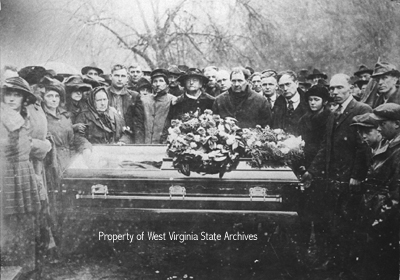 At the funeral of Anderson Hatfield, left to right: Thelma Latelle LaFollett, Mrs. Elliott Hatfield, Nancy "Sis" Hatfield Vance, Rose Hatfield Browning, Mrs. Anderson Hatfield, Tennis Hatfield, Elliott Mitchel, Elizabeth Hatfield Caldwell, Jonse Hatfield, Smith Hatfield, Emma Smith, Elea Hatfield, C. A. Hatfield, "Cap" Hatfield, Bob Hatfield, Dr. Elliott Hatfield, Murel Hatfield Beres, Joe Wolfe, Ples Browning, Cook Boys.
At the funeral of Anderson Hatfield, left to right: Thelma Latelle LaFollett, Mrs. Elliott Hatfield, Nancy "Sis" Hatfield Vance, Rose Hatfield Browning, Mrs. Anderson Hatfield, Tennis Hatfield, Elliott Mitchel, Elizabeth Hatfield Caldwell, Jonse Hatfield, Smith Hatfield, Emma Smith, Elea Hatfield, C. A. Hatfield, "Cap" Hatfield, Bob Hatfield, Dr. Elliott Hatfield, Murel Hatfield Beres, Joe Wolfe, Ples Browning, Cook Boys.
After scanning the entertainment press, consequent to watching the program, I was a little freaked out to see one of the networks was launching a search for descendants of the two families to put together in a reality TV scenario. At first I was disgusted, then pissed. Then, I thought, this might be interesting! I'm not sure the producers knew what they were asking for. Speaking of interesting, during the celebratory press surge, attending to the great ratings "Hatfields & McCoys" garnered, the news came forth that one of the stars of the show, Kevin Costner, was embroiled in a legal battle with another actor, Stephen Baldwin, over profits from investments on technology brought to bear on the ecology-destroying and -deforming BP oil and chemical spill, in the Gulf of Mexico, off the US southern coast. ...And I thought movie stars only wasted their big paydays on lavish homes, drugs, multiple spouses, parties, cars, diamonds, fine clothes, high-end lawyers and other such luxuries. Well, at least one of those is right.
Ultimately, though, the "Hatfields & McCoys" show, which was filmed in Romania (Really. See “Hatfields & McCoys” Filmed in Romania? West Virginia Snubbed Despite Film Incentive http://www.stop-runaway-production.com/2012/06/08/hatfields-mccoys-filmed-in-romania-w-virginia-snubbed-despite-film-incentive/), broke records all over the place for viewership, as mentioned above. It's great to be popular, or at least it was for a week, in West Virginia. Then came a recent poll painting the state of West Virginia, the only state that abandoned the Confederacy to join the Union during the Civil War, as racist. Here's a worthwhile story on the latest news, and a brief, largely anecdotal, historical overview (http://www.thedailybeast.com/articles/2012/06/19/west-virginia-sigh.html) by a Mountain State native. The politics of West Virginia has changed radically, since I was boy growing up there. Back then, it was Blue Dog Democrat. Now, it's Republican. Michael Tomasky's essay suggests the Southern Baptists might be behind the shift. Maybe so, but I would argue that Rush Limbaugh, Sean Hannity and Right-Wing radio and FOX TV are more likely responsible. Which loops us back to the power of media on identity, on perception, on choice.
 William Sidney ("Sid") Hatfield
William Sidney ("Sid") Hatfield
My mother was a labor historian. I was raised on stories about another Hatfield, Syd (also have seen it spelled "Sid"), who was a law officer in Matewan. Syd Hatfield, as memorialized in John Sayles' movie Matewan, fought a gun battle with Baldwin-Felts agents, and the Felts took the worse of it, losing their lives. For context, here's an account of the mine wars in West Virginia (* Note the site: http://www.globalsecurity.org/military/ops/west-virginia-1919.htm) in the first quarter of the last century, which also mentions another Hatfield, West Virginia Governor Henry D., who "proposed that the operators concede to the miners the following points: right to organize, a 9-hour work day, right to trade in other than company stores, semi-monthly pay days, and no discrimination against union men. Both the miners and the operators agreed to these terms, and the strike ended April 28, 1913." It's doubtful that corporate "Hollywood" will be rushing to produce movies or TV stories on this important part of American history anytime soon.
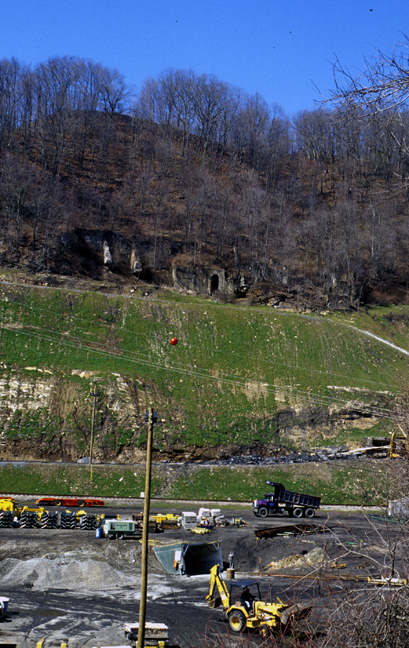 Photo by Paul McLean (2001)
Photo by Paul McLean (2001)
Fast forward to now, and recollect the latest news from the minefields of West Virginia. The Massey Upper Big Branch mine disaster of 2010 at Montcoal: were any of the infamous executives of that non-union outfit, that multinational extraction-exploitation syndicate prosecuted after their murderously poor management practices killed 29 miners? No, the infamous union-busting CEO Don Blankenship got to retire, to live the life of Reilly in Cannes (I heard). Here's a little biographical detailing on Blankenship:
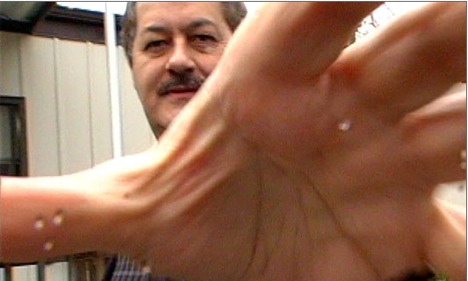 Don Blankenship
Don Blankenship
>>
Don Blankenship was born in Stopover, Kentucky and raised in Delorme, West Virginia. His father served in the Korean War, and his mother was a member of the McCoy family; they divorced soon after Don was born, and Don's mother ran a convenience store and gas station with her divorce settlement money. Three years after graduating from Matewan High School, West Virginia, and earned a bachelor's degree in accounting from Marshall University in 1972.
...
U.S. Securities and Exchange Commission filings show Blankenship was paid $17.8 million in 2009, the highest in the coal industry. His 2009 pay represents a $6.8 million raise over 2008 and almost double his compensation package in 2007. Blankenship also received a deferred compensation package valued at $27.2 million in 2009.
<<
 Devil Anse (Psinting by Paul McLean)
Devil Anse (Psinting by Paul McLean)
I went to school with some of the Blankenships. They aren't all like Don, who I bet some of those dead miner families would like to see frog-marched behind a mule (or a pick-up truck) a while, tied to a tree after some special treatment, and lit up like a Roman candle. Make a movie about THAT... Or Mother Jones, or where the term "redneck" comes from, the coal miner army that was bombed from the air by Federal forces as they marched on the state's capitol... Or make an Erin Brockovich-style movie about the families resisting the onslaught of mining companies bent on turning the North American continent's most diverse ecosystem into a toxic sludge dump. I went to school with some of those family's kids; was it the Gilliams or the Gillian's? I'm having a hard time remembering. One of their relatives used to cut my hair. Here are some fun facts about mountaintop removal.

>>
* More explosives are used every week in the extraction of coal in Appalachia, than were used in the first gulf war, and the Afghanistan war combined
* Close to 2.8 billion gallons of toxic sludge, produced by "cleaning" coal before burning it, lies behind an earthen dam just a few hundred yards upstream of an elementary school in West Virginia
* Over 1000 miles of streams have been buried and 500 square miles of mountains supporting one of the world's most bio diverse temperate forests have been destroyed by Mountain-Top Removal coal mining in West Virginia alone
* According to the West Virginia Coal Association, a little over 50 years ago, over 100,000 miners were employed in West Virginia, In 2003, that number was fewer than 15,000. Meanwhile, far more coal is being mined
<<
Coal River Mountain Watch - West Virginia
 New River (Photo by Paul McLean)
New River (Photo by Paul McLean)
Did you know that Bank of America, based in Charlotte, is also the Bank of Coal? LOL. Some things never change, do they Mr. Rockefeller, over there at MoMA. The universe is a big ole loop'de'loop, it seems sometimes. It's dimensional. [offscreen, murmurs] Oops. I have a correction to make. The Rockefeller connection is Chase bank, and Standard Oil, not coal. Are you sure about that? [offscreen, more discussion] What about Ludlow? Mother Jones was there, too? Right. Senator of West Virginia. Crazy, right? Real banana republic shit...
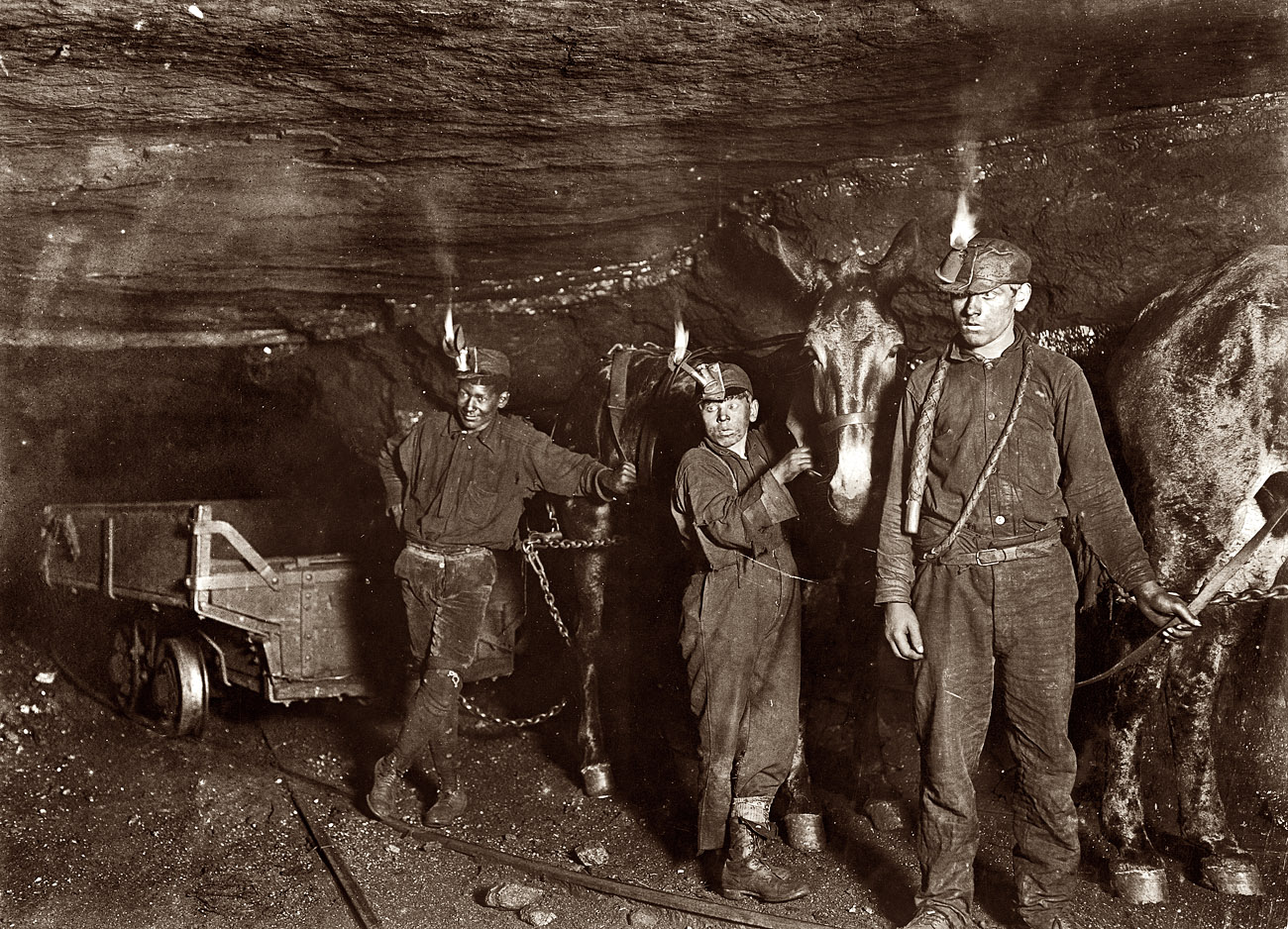 West Virginia coal miners and mules with open flame lamps, 1908
West Virginia coal miners and mules with open flame lamps, 1908
I'll close out on the subject of West Virginia with a couple of thoughts. On the topic of racism and mountaineers, and Obama. What has Obama, or any other American President since Ronald Reagan done for the working people of West Virginia? What has Obama, in particular, done for West Virginia? Did he have the minerals, as they say, to use an executive order to launch a jobs program like the WPA for the state or the region? Medicare for all? Fund public education? Stop all the multinationals, who prosper enormously, in part by keeping West Virginia poor? ... And as for racism. Is it not still politically correct to spew hate at the people of my home state? - Especially amongst the intelligentsia, the elites, and any of the rest of a long list of social circles, for whom a hillbilly or redneck is still fair game? And is that not an -ism, conforming to the oldest precepts of the culture of extraction and exploitation, to "make fun of" or hurl epithets at those made slaves or otherwise impoverished by the 1% industrialists, the bloody-fingered Robber Baron, of then or now?
By the way, here's the list of West Virginians who died on the beaches of Normandy on June 6, 1944 (http://www.wvculture.org/history/military/ddaydeaths.html):
West Virginians Who Died On June 6, 1944
Extracted From the Veterans Memorial Database
- Feathers, Curtis C
- Alexander, Winston Lodge
- Boggess, James O
- Casto, David E
- Colangelo, Donald G
- Crites, Darius W
- DiCiuccio, Joe
- Elswick, Jasper N
- Greene, Silbert P
- Hawkins, Jesse M
- Heck, Elsworth M
- Hughes, Martin V
- Jones, Edward L
- Knight, Alva Jackson
- Kuhn, Eston C
- Lake, James D
- Lipscomb, Bernard H
- Manfredi, John
- Manning, Charles H
- Mason, Conrad Cecil
- Mathews, John Hobert
- McCalvin, Charles G
- McComb, Jamie Edgar
- McCue, John Burk
- McDaniel, Vernon C
- Miller, Norman G
- Mollohan, William L Jr.
- Nesci, Louis F
- Phillips, Shirley J
- Shreves, John Henry
- Smith, William H
- Spiker, Floyd
- Stemple, Max L
- Stonebraker, Robert Charles
- Winebrener, Raymond L
- Winn, Benjamin F
- Wirtz, Benjamin H
- Wolverton, Robert L
In all, about 5000 West Virginian servicemen gave their lives in the Second World War. (http://www.archives.gov/research/arc/ww2/army-casualties/west-virginia.html)
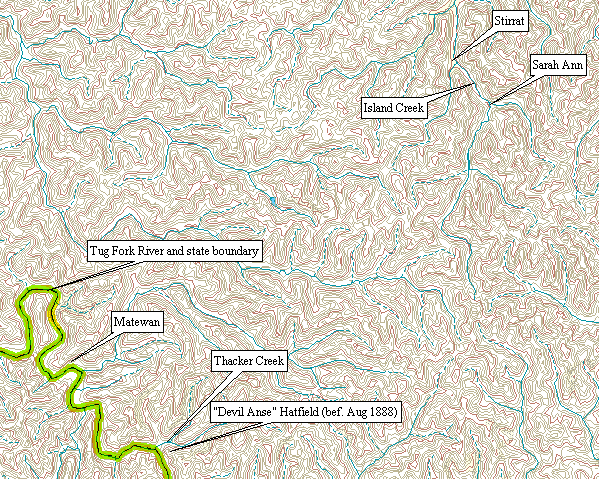
∞
Encoding the connective tissue of consciousness, as a simulated mapping process, is inherent to dimensional methods, for art, for analysis, for forming any set of information that involves progressive development over time, especially directional progress. Media only asserts itself as a superimposition of newness on this phenomenon, or more correctly, phenomenal-dimensional-event-awareness. Media shouts "Eureka!" in the same thread of discovery that colonialism always applies to unclaimed or uncharted territory. It never asks whether the "new" territory wants to be territorialized or not. This was and is always "new media's" problem. Its fundamental fixture is still a command code to spark an interaction, which makes every interaction an intervention. Media, in its component technologies, will be new as long people continue to tinker with the latest tools, code, theories, but until media stops its adherence to command, it will be the same old, same old: an ingredient in the recipe for general disaster, providing a few folks' fortune.
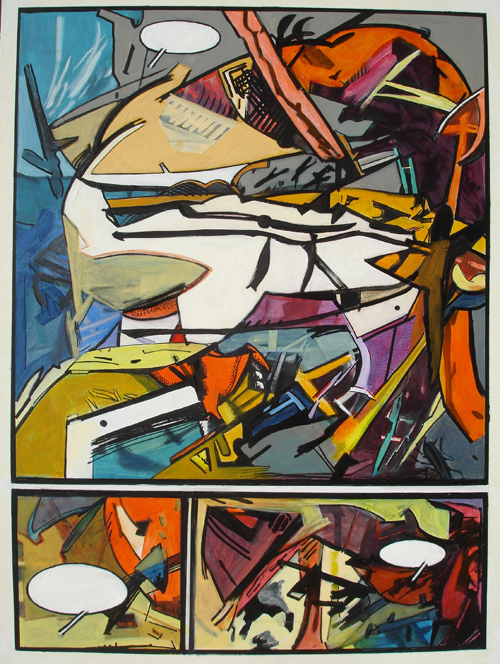 Painting by Manning Williams
Painting by Manning Williams
>>
"I was continually surprised," said Tony Horwitz in a recent telephone interview, "by the depth of passion Southerners still feel for the Civil War."
That surprise helps and hinders Horwitz as he takes us on a literary campaign through the Old South. To his credit, Horwitz has recognized two basic truths about Southerners: (1) we're really tired of people telling us how strange we are, and (2) many of us really are strange, especially when it comes to the Civil War.
Take, for instance, Manning Williams, described in the book as "Charleston's leading secessionist." Williams has some great lines in the book, telling Horwitz, "It seems peaceful out there, but don't get fooled. The War is emotionally still on. I call it the thousand-year war. It'll go on for a thousand years, or until we get back into the Union on equal terms."
Like many other Southerners, Williams prefers not to use "Civil War," telling Horwitz the "War To Suppress Yankee Arrogance" is an acceptable substitute.
Williams is reflective of Horwitz' ability to tell his story through colorful yet ordinary characters, men and women who work hard, go to church, pay their taxes -- and spend much of their spare time researching and/or re-enacting the Civil War. A Wall Street Journal reporter and winner of the Pulitzer Prize for National Reporting, Horwitz knows how to write.
<<
-"Appomattox? What was that? The Civil War, a new book reports, is hardly over," by Chuck Mobley Savannah Morning News, a review of Confederates in the Attic: Dispatches from the Unfinished Civil War by Tony Horwitz
∞
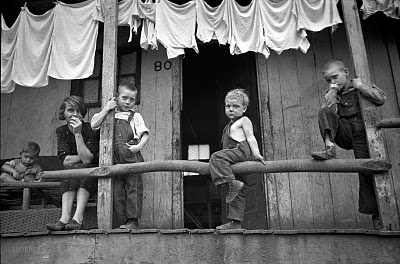 Coal miner's children and wife, Pursglove, West Virginia
Coal miner's children and wife, Pursglove, West Virginia
It's just chronicler romanticism, hype or hubris to push the concept that documentation is what makes the real, real. Or worse, the simulacra of documentation germinates the utilitarian version of reality as translation, for purposing, which is inevitably, eventually propagandistic. It is the medium, then, of hearsay, seen, as as a scene rendered as artificial realism.
When reportage merges with agency, we get propaganda. In perception, propagandizing is a violation of scientific protocols, not an expression of it, no matter what a propaganda expert might think or tell you. That's why propaganda-saturated people become so averse to science over time. Propaganda instructs perception. It only asks questions for which it has answers. Relying on propaganda to shape consciousness and perception, which are not identical, retards the natural evolution of consciousness developing from perceptual inputs. Propaganda tells you what to see, or tells you what you see is wrong, if you're not seeing in alignment with the propaganda. If this process over time, propaganda correcting the seer who's getting it right, and telling the seer what she sees is wrong, the sure outcome is enforced madness, a perceptual complex.
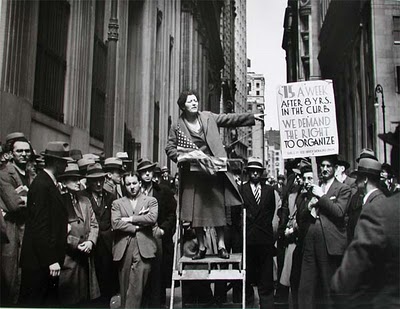 Carl Mydans: A Pioneer Organizer Of The Office Workers' Union, Wall Street and Broad Street, NYC, 1936 ©Time, Inc
Carl Mydans: A Pioneer Organizer Of The Office Workers' Union, Wall Street and Broad Street, NYC, 1936 ©Time, Inc
So, we can think of television broadly as a means by which mass perception is shaped, distorted or directed, as attention. That's certainly nothing new, as realizations go. To begin this introduction, we noted the absence of programming acknowledging the sacrifices of Allied servicemen on the beaches of Normandy, on the 68th anniversary of D-Day. The (mostly American) servicemen killed in the World War 2 invasion of Europe in June of 1944 gave their lives, for what and whom? Memorializing such events defines a nation, its people, its values. To what end would monopoly media erase our history, by disconnecting this important part of it from the social, visual calendar, which today is in large part enunciated via television and other electronically transmitted, digitized and networked media devices for a big chunk of the country's population?
>>
Dear all;
The Open Source Imperative was delivered at the doorsteps of the plenary where the heads of state were opening the official Rio +20. It was as far as my pass would allow me to go. Nonetheless, it was a great action, where i brought a old 1970´s functional typewriter and typed/danced in solo as delegates stopped puzzled. When they would ask me what i was doing, why the typewriter, i would say ´´typewriters are like life or the planet; you make a mistake and you cant go back`´ and would give them the Open Source Imperative. Super cool action, joUrnalists from all over kept filming and photographing. Tomorrow i'm back for a second round.
Let´s keep rocking!
Ale
<<
Carl Mydans: 1937 WPA Progress Strike ©Time Inc
∞
What is art? Or to reframe the question for the purposes of this discussion, what is art as media packet? Occupy has in some truly impressive ways caused a recalculation of art in the present tense. OWS has done so, dimensionally, primarily as a variable confrontation. The Occupy art platform is at least bi-polar. On the one hand, OWS entertains claims that it *is* art, that it consists of artists, that artists are instrumental to the movement, or at least the *meme-ment* of occupation. On the other hand, several of the most high profile art-related activities emerging from OWS involve sometimes virulent assaults on art world institutions and practices. So there exists a tension between internal art occupation and external Occupy art occupations. The invasion of Artists Space, the ongoing campaigns against unpaid interns (Arts & Labor) and a few New York museums, art fairs and auction houses (Occupy Museums), establish a dynamic of critical distance for engagement, even if the intervention as such or occupation is occurring within the institution, whether as direct action or by invitation. The "art" in such encounters is empowered by negation, and claims to the contrary only amplify the confusion of medium and purpose. Somewhere in the mid-space of these poles extremis are the kitchen-sink exhibits of Occupy "art." Defining Occupy art is never easy, and one reason for that would be the ana-critical programming of Occupy from the outset, which is, in my experience, potentially opposed to everything and inclusive of it simultaneously, and since "it" is always in flux, the metrics of against- and inclusivity are fungible as the occupier expressing the position. In the OWS culture, definition, categorization, grouping and hierarchy are suspect, no matter what criteria might be introduced to support a given architecture for rational dimensional production. Each basic tool is relentlessly subjected to critique, as if critique is capable of production. A position for- must be systematically confronted by a position against-. If we imagine org-behavior in terms of dimensional mechanics, like geometry, no matter what the point (of origin, of a conversation or problem-solving session), line (of reasoning, pattern of development...) or form being considered (for repeatable implementation formatting), endless scrutiny of each element in the array and the ties that bind them (not to mention identity of idea-proponent), paralyzing in a grouping or assemblage, . Because art has been subjected to so much deconstruction, opposition, and reformation over the past century+, and the discourse in(to) which it is subject(ed) is practically hardened into a simulation of art itself, the Occupy ersatz art critic - in NYC anyway - will often have a catalog of handy dialectic attacks at the ready to protest any assertion about or for- art, as such. Conflation of art and art market is almost uniform.
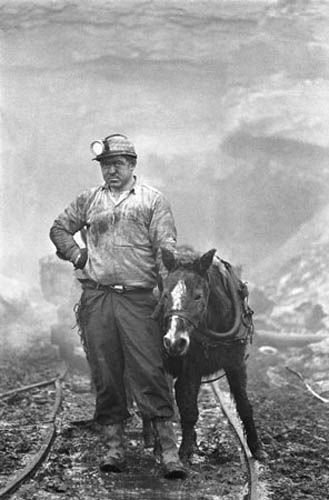 Eddie Adams: Coal Miner, West Virginia, 1969
Eddie Adams: Coal Miner, West Virginia, 1969
Beyond the binaries and negations, the quandaries precipitated by a "global" protest art movement are manifold. The Beuys/Warhol+Situationist+Duchamp school champions art-as-everything/everyone-an-artist as default, but persists in relegating art to the role of protest utility. Recently a curator assembling a feature on Occupy art for one of the old-school 68er Revolutionary art periodicals put a call out for Occupy art beyond photo documentation, refining her call for submissions this way:
>>
After looking through the photos people have been sending, though, I think I should clarify something: what I'm looking for is images of street art, posters, internet memes, creative disruptions, etc. - "protest art," in other words - as opposed to documentary images of the occupations and protests in general. The idea is to highlight some the ways in which visual / material production has been used as a form of public intervention.
<<
OWS/NYC General Assembly Arts & Culture has been an umbrella for a fairly expansive array of creative expressions of or accompaniments for protestations of 99% grievances. One unresolved question is where an artist starts and an Occupy artist begins. The question is confounded by the negation of art and artist as translatable in the Occupy schema. Which is, in the end not a movement, but a stylization, a mediated version of one. Occupy doesn't exist, to tell the truth, and it never did, which is why the 1% really ought to be afraid, because they are likely to lose everything, now.
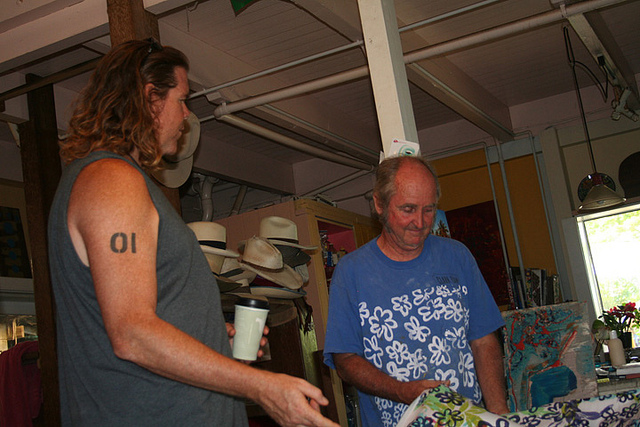 Ambrose and the author
Ambrose and the author
[ENDQUOTES]:
how thick is the deck and bottom remaining wood?
1/2 the weight ! formidable...
I am glad you revealed its not done
I was concerned about the plan shape resolution
and now there is hope the template will smoothe out...
...ambrose...
what tool method did you use to split the blank?
balsa used a beam saw.
I am interested as I am on the splitting step
and am short a beam saw
another method would be verry cool
as I sit here I am tempted to use a hand saw...
ambrose m.curry III
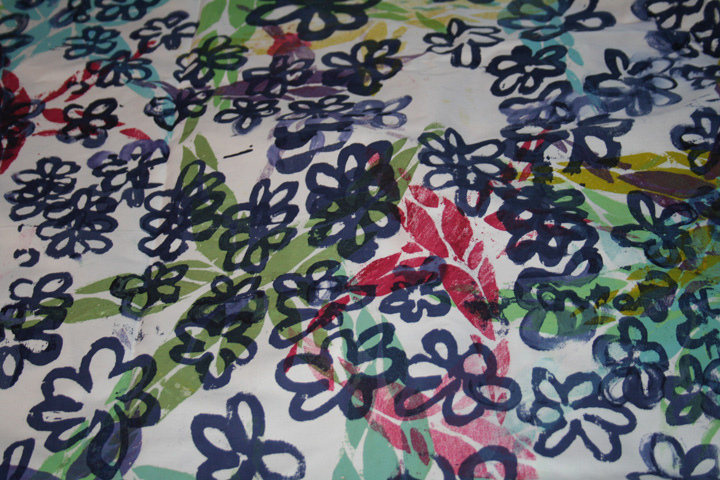 Abrose Curry fabric design
Abrose Curry fabric design
[Through the pipeline]
>>
Good Morning...
I suggest that the Occupy Wall Streeters construct a couple of workable guillotines, parade one down Wall Street the other down D,C.'s Pennsylvania Avenue. Send a message on .Bastille Day, the 14th of July.
This web site has detailed instructions:
At this web site you can buy the complete plans, download them as a pdf file:
There is no democracy, not even a semblance of one, where there is such a great, and growing, disparity in wealth.
S. Russell
<<
>
>>
1 June 1940 Colville Diary
***
At this same moment, the Director of the National Gallery, Kenneth Clark, suggested that the paintings in the National Gallery should be sent from London to Canada. Churchill was likewise against this suggestion, and emphatically so. “No,” he minuted, “bury them in caves and cellars. None must go. We are going to beat them.”
<<
- Winston S. Churchill, by Martin Gilbert, vol. 6, Finest Hour 1939-1941, page 449
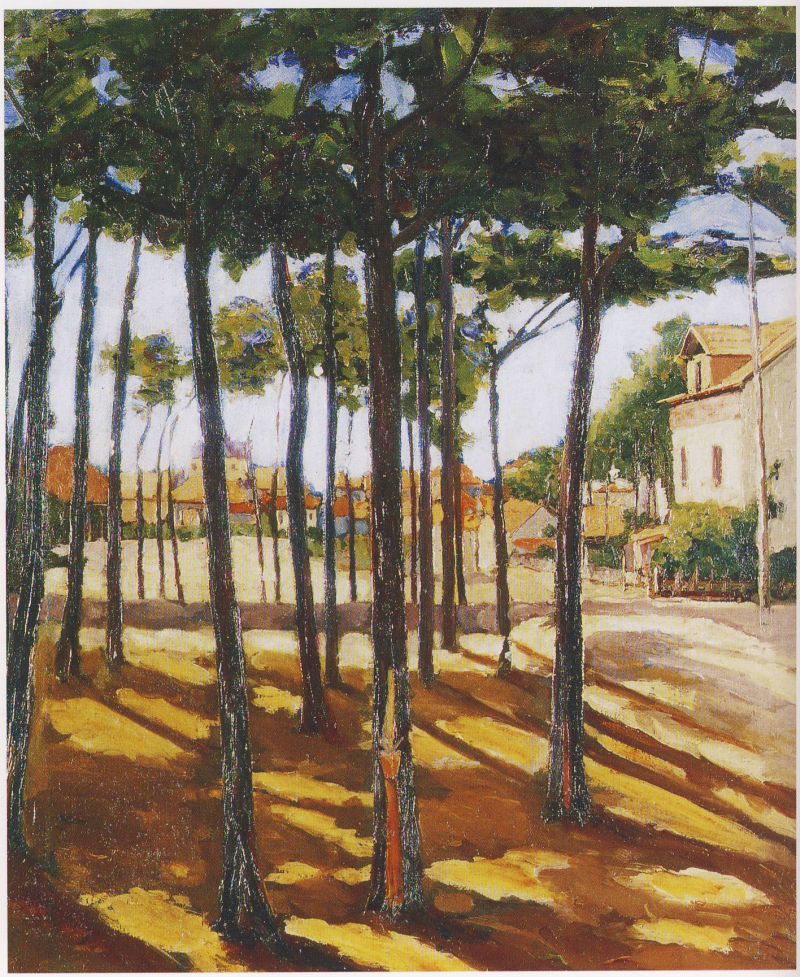 "Mimizan Plage, Landes" by Winston Churchil
"Mimizan Plage, Landes" by Winston Churchil
[ENDING FRAGMENT]:
 Cain Motter's guillotine on the streets of LA
Cain Motter's guillotine on the streets of LA
//OK, that's an anthropomorphic projection. The art world, as such, is not an organism, much less a corpus, or corporation. It only behaves that way, dimensionally, and in some aspects, with regards incorporation, due to org-infection. The phenomenon of an artist serving the system of industrial art as an expression of solidarity with it for the purposes of furthering career ambitions is hard to reduce to outright complicity. It's not easy to prove that an "independent" artist is in cahoots with the 1% art world. For one thing, the art world is maintained as an unregulated, ethics-free zone, at that level, although words like "integrity" and "trust" are often used in its context, sometimes truthfully. Art world mouthpieces like Jerry Saltz take every opportunity to defend the art world's amorality or immorality. The means by which the folding of "culture" into art occurs is de-centralized, and usually from the bottom-up actualized through the interpretive or translating activities undertaken by "artists" who take pains to be (in)visibly operating independently or autonomously from the system(s) they are part of. The myth of studio isolation as a romantic trope, and the pragmatic realities of studio craft for painters (which doesn't apply to many applications or practices that have merged into the broad field of de-defined art today, such as performance) spiral through the station of the artist in systems that alternately condemn the artist's life as useless and reward it with breathtaking sums of cash (and other sorts of rewards).
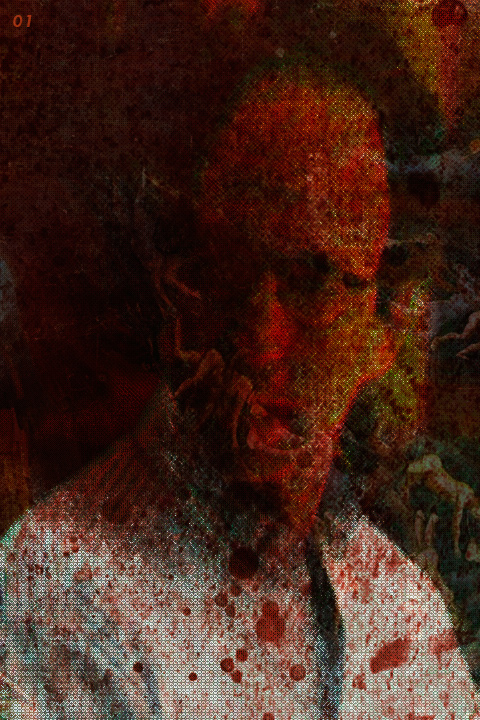 "Jerry," by Paul McLean
"Jerry," by Paul McLean
[CORRECTIONS, EXPLANATIONS + MORE REFERENTS & LINKS]:
- I found two of the illustrations (videos from Korea) included above when I accidentally misspelled Taeyoon Choi's name during a Google search.
- In the current issue of the Brooklyn Rail, several articles informed this one. Robert C. Morgan's review of Joseph Nechvatal's exhibit at Galerie Richard is one [Joseph donated many texts that are quoted in the SoO and ENOUGH! sequences, and has been a consistent and valued supporter of the author and OwA]. Another is the brilliant essay by Timothy R. Quigley, "Writing from Nowhere," a response to which can be imagined in the inverse as a point of origination for another work, "Writing Everywhere." (see Tuttle quote above, Ale's action, etc.). I'll close the segment with the opening lines of the article, but it is worth reading in its entirety.
- I should acknowledge Ted Hamm's support in the writing of ENOUGH, and Christoper Moylan's, too. Without their valuable feedback, it would not be sustainable. The SoS/E[B] cycle will appear in some compressed iteration in the September print issue of the Rail, although some portions will be published on the BR website.
- OwA will be undertaking an eval program, focused on the first nine months of progress and production, and formulating a strategic plan for year 2. In the meantime, we will be proceeding with CO-OP/Occuburbs.
The essay, “From Metaphysics to Invective” by David Levi Strauss, is about the relation between artists and writers—about art-making and a form of writing generally referred to as criticism. It’s an appeal for writing and collaboration, beyond the constraints of the art market. Strauss is looking to repair a significant, but temporarily damaged relationship, and to clear the obstacles separating artists and writers. “We are currently suffering a crisis of relative values that could be treated with criticism,” he says. “Without criticism, the only measure of value in art is money, and that measure has proven to be both fickle and stultifying.” Artists today are held hostage to the marketplace—a network of commercial enterprises including art galleries, auction houses, and corporate “sponsors.” This leaves their natural and historic collaborators, the writers, in an awkward and precarious position. Quoting from an essay by Dore Ashton, Strauss makes clear what’s at stake: “If art criticism is [also held] hostage to the marketplace, and if the destiny of an artist’s work is to be evaluated on an eternal abacus, something vital has been lost—that is, good conversation among artists and their viewers.” And so, Strauss claims, “if criticism is devalued,” artists have no other choice but “to heed the market’s siren song.”

 admin
admin
To OwA list:
Hey all
you're either getting this note because you're mentioned in the essay, or invited to help on it, or both...
I've been hammering at this one for a couple of weeks, now... as per the instructions and introductory notes, the structure of the text is essentially framed as a proposition for a new model of exhibition design, although I intentionally was circumspect in communicating how I'm thinking this can translate into an actual installation/performance work that at this point I'm thinking we'll launch in the barn in Huntington, as part of CO-OP, although that's not set in stone.
You can think of it as the light sticks for a kite to be constructed, or a sweat lodge.
love you all; will make face2face and/or phone/email time (by appt, if necessary) for any who would like to do so/has time-energy to commit to it.
Let me know when/how's good for you.
warmest regards,
p
[From Chris Moylan]
Yo:
Here are my reactions to your epic piece.
As I see it, you pivot from the middle class-proletarian sense of enough! so beautifully articulated in your first essay (what is enough for us? dare we ask? isn't asking for enough now by necessity an act of defiance--enough! and so on) to consider the %1. You argue that enough has no meaning for these people,that EVERYTHING is the operative word for them--a drive not just to monopolization (just!) but to complete control of government, media, technology, cognition, everything.
So what can anyone do? what is the weak point? I think you are saying that art is, to the extent that it can extricate itself from all of the above. One way for this to happen is via technology (the 4 dimensional penetration of the matrix) and the other is through good old fashioned non-monetized exchange of value--barter for paintings, other forms of non-art world mutual support,and so on. But the marginalization of Occupy and the co-optation of art studio weekends and so on threaten that. What's more, the anarchist we are all free agents methodology (and ideology) that is so liberating in the street (direct actions, etc.) is fragmenting and destabilizing at the level of the culture or the community.
This new piece is very, very necessary. It's just a relief to have it. It's the slingshot. Can't wait to use it.
You come round to making this argument, though, towards the end of your piece rather than the beginning, and even then you wander away from it. Throughout, I don't quite understand the importance or relevance of the artist from Charlotte. What does he represent? Why is his work important? Are you simply lamenting the death of a neglected artist, or does his work illustrate something particularly germane to the structure of your argument?
Similarly, I couldn't quite follow the remarks on time and Time-Lapse at the beginning of the piece. Here you rely on a back slash accumulation of categories that can get pretty confusing. Look at this sentence:
Before the fact, the project of doing this ENOUGH entry seemed a rather dull and anonymous exercise - I mean, the whole world isn't watching Occupy, now it would seem - a struggle/mission/task of responding to some essays that impact art and Occupy, making some general assessments about media practice affecting mass perception, focused on the erasure of national and regional history, calling out the top-down art/academic/philosophy/media/press complex's sublimation or outright repression of Occupy art, and folding it into the "new," chronicling how artists accomplish the same thing from the bottom-up - binding all of it with autobiography and anecdotes, the subjective.
Do you understand it? I want to understand it. I think you're getting at some fascinating things, but the grammar isn't working and it's just too hurried and compressed.
Same is true for this sentence:
There are a fair number of painters like him, although it seems fewer and fewer - but this may be but seeming.
---Well, are there a fair number or not? Seeming to whom and it what way? It's just a style quibble but look at what happens to your writing when you take on the corporate mega-assholes:
America has become a nation in which exceptionalists do all they can do to destroy nationalism, [where they] eradicate [not only] the means by which the country can protect and provide for itself, but also the legitimate sources of national pride, sustainability and stability. In the corporatized, multinational schema, though the whole exceptional thing flipflops[I don't quite understand this sentence]. "Buy American" is a verboten slogan, for example. The free market is placed before the Home of the Free, except when it comes to the practice imperial, international tyranny and terror on the neo-savages [I think neo-savages is a bit over the top].----
I could go into the elements of classical rhetoric you use--the periodic construction, parallel structure, etc.--but the point is (aside from a bit of tinkering that I do in the brackets) when you zero in on the target, and it's a big target (thus the Goliath idea) your writing kicks ass. When you discuss the art world, though, the writing tends to meander and you substitute profanity, lots of it, for argument and statement of premises. I know I'm an outsider and I don't understand a lot of things, most things, about the art world, but my intuitive sense, which could well be just uninformed or whatever, is that when you talk about them (art world types) you write like them. What you have to say in this piece, however, about art and the art economy and its implications for human liberation is just too important to fuck around. You're Tom Paine when you take on Gates and company; I wish you would be Tom Paine when taking on Roberta Smith and company.
Man. I'm writing longer than your piece! I hope I'm making some sense and I hope I'm conveying how fundamentally blown away I am by what you're doing and what you are constructing conceptually. Long and short of it is, I do think this should be published, should reach an audience of your peers, of lots of people, so that's the motivation for my being a pain in the ass from the margins.
Time for me to watch aliens destroy Los Angeles. Bout time.
later
p.s. Occupy LI and OWS are assaulting the Koch estate on the east end of LI on 7/8. Much energy among the peeps for this one. Hope they do show up.
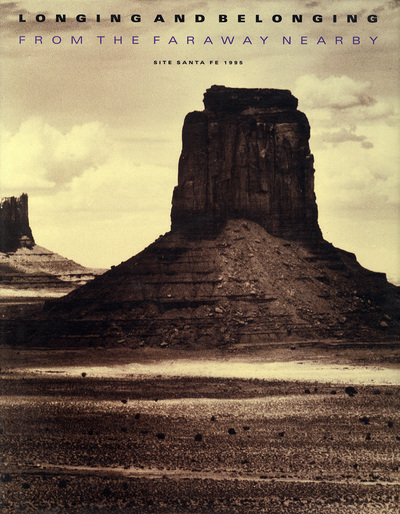


Reader Comments